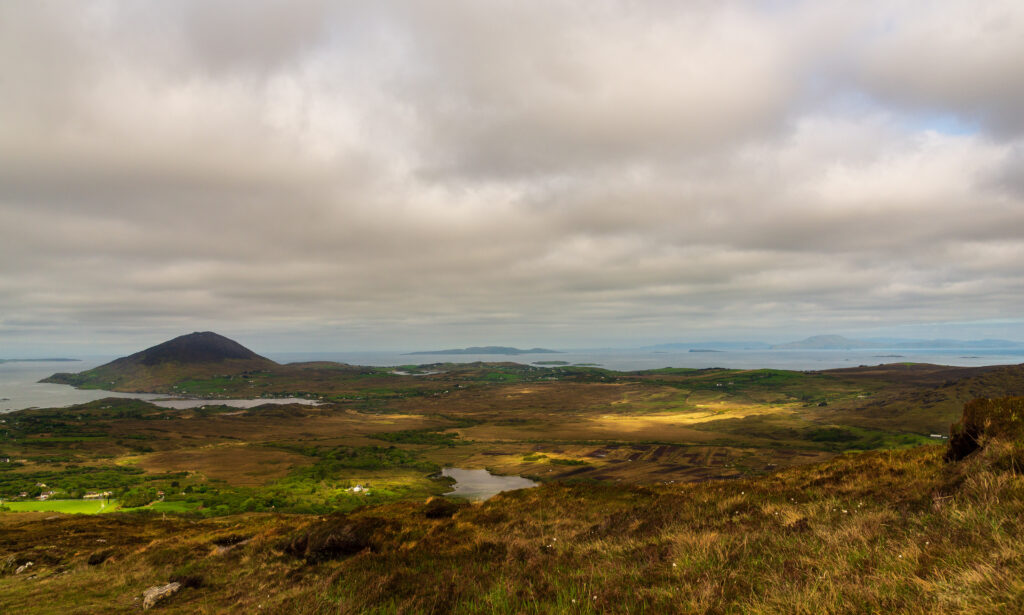Ireland: Where My Journey Across the Pond Finally Began
January 2020 began like any other year, ringing in the New Year and making resolutions. One of those resolutions was to travel more. With that in mind, we began planning my first international trip with Rick Steves: a tour through Turkey scheduled for March. The timing felt poetic, celebrating my 50th birthday surrounded by ancient ruins, vibrant bazaars, and centuries of history.
But in March 2020, the rhythm of daily life came to a sudden halt and changed indefinitely.
Like so many others, I watched my plans unravel into a chaos of cancellations and uncertainty. My milestone birthday came quietly; without the adventure I had imagined. For a time, even the idea of travel felt impossibly distant.
Two years later, in 2022, we finally crossed the Atlantic, not to Turkey as we’d once planned, but to Ireland. A land of endless green hills, an idyllic lifestyle, and plenty of sheep, just as I had imagined it would be from The Quiet Man.
Dublin
Our adventure began in the capital, where academic brilliance and dark stout flow in equal measure. A great first impression came from our taxi driver, who chatted cheerfully on the ride from the airport, pointing out the best pubs, places to eat, and which ones to avoid.
Once settled into our room at the Dublin Citi Hotel, we hit the streets for some urban wandering, exploring the city, soaking up the atmosphere, and sampling a few local flavors.


Trinity College – The Book of Kells
The next day, we visited Trinity College to see the Book of Kells exhibition. This masterpiece, is a richly illustrated Latin Gospel manuscript written on vellum, a true work of art. Created by three artists and four scribes in the 9th century, it dazzles with intricate decorations and vibrant pigments.
In 1006, it was stolen from Kells Abbey for its jeweled cover and recovered 88 days later. Today, it draws more than half a million visitors annually, well worth the admission and a must-see for anyone visiting Dublin.
After exploring the exhibit, we went upstairs to the famous Long Room in Trinity College’s Old Library. Stretching nearly 65 meters, it’s one of the most impressive libraries in the world. For centuries, its dark wooden shelves held more than 200,000 of the library’s oldest books.
Today, the Long Room is undergoing a major restoration project. Each book is carefully removed, cleaned, measured, and stored for safekeeping. Though many shelves now stand empty, visitors can still walk through the hall and witness this once-in-a-lifetime preservation effort. When complete, the Long Room will be restored to its former glory, ready for future generations to see its shelves filled once again.
Learn more about the project here:
Old Library Redevelopment Project | Trinity College Dublin (visittrinity.ie)

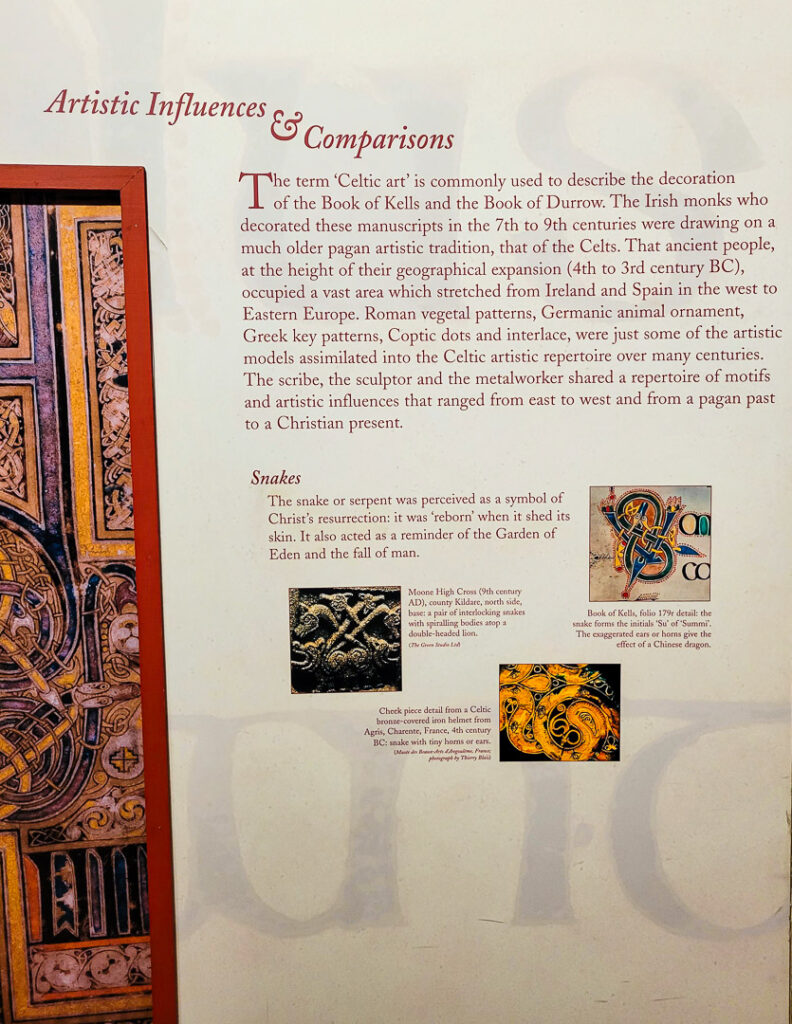
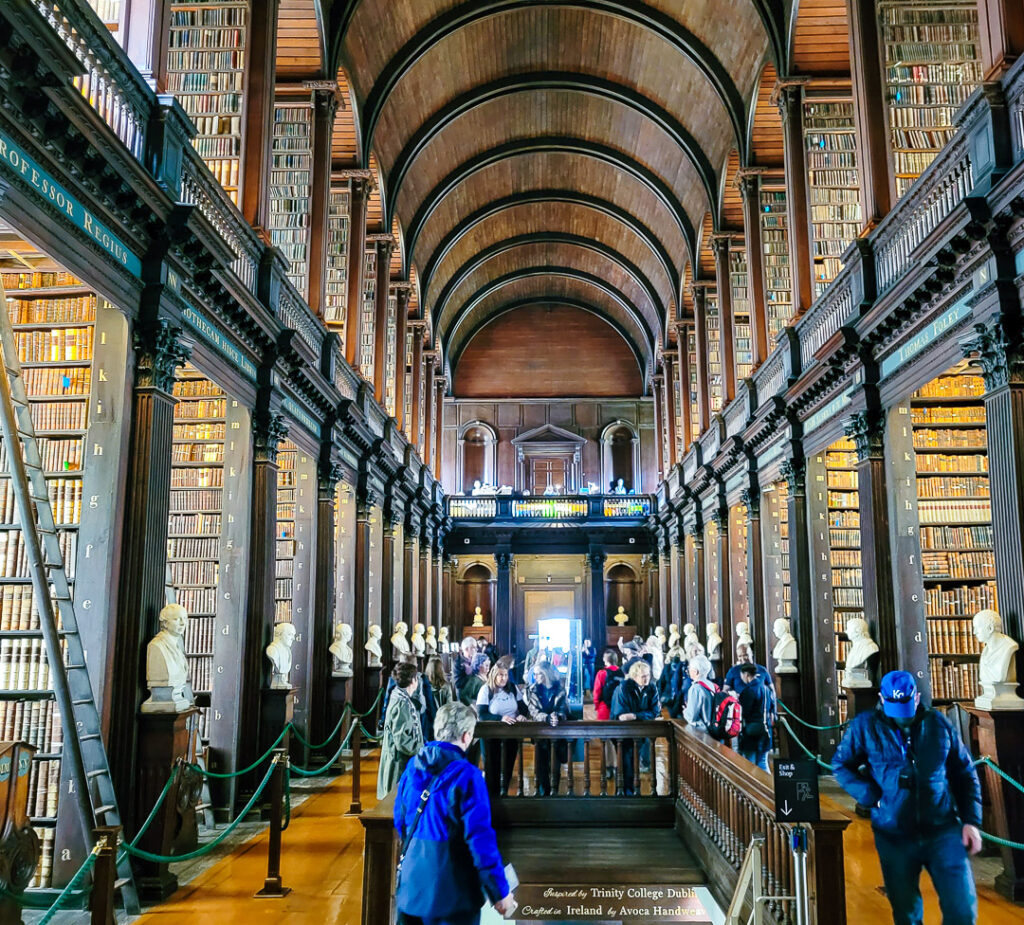





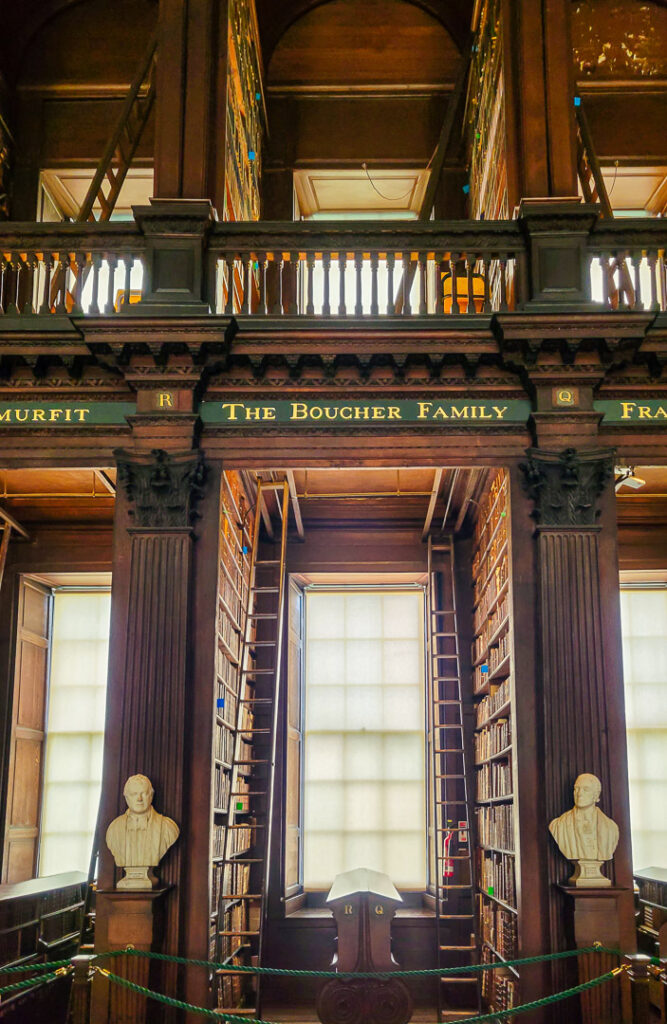

Saint Patrick’s Cathedral
We walked across cobbled streets into some of Dublin’s most picturesque neighborhoods. From a distance, Saint Patrick’s Cathedral rises into view, framed by gardens and a peaceful park, a calm oasis amid the city’s bustle.
Founded in 1191, the cathedral has stood for centuries as a testament to Dublin’s history and faith. The interior is equally impressive, with soaring architecture and historic details, including The Door of Reconciliation and the Choir.



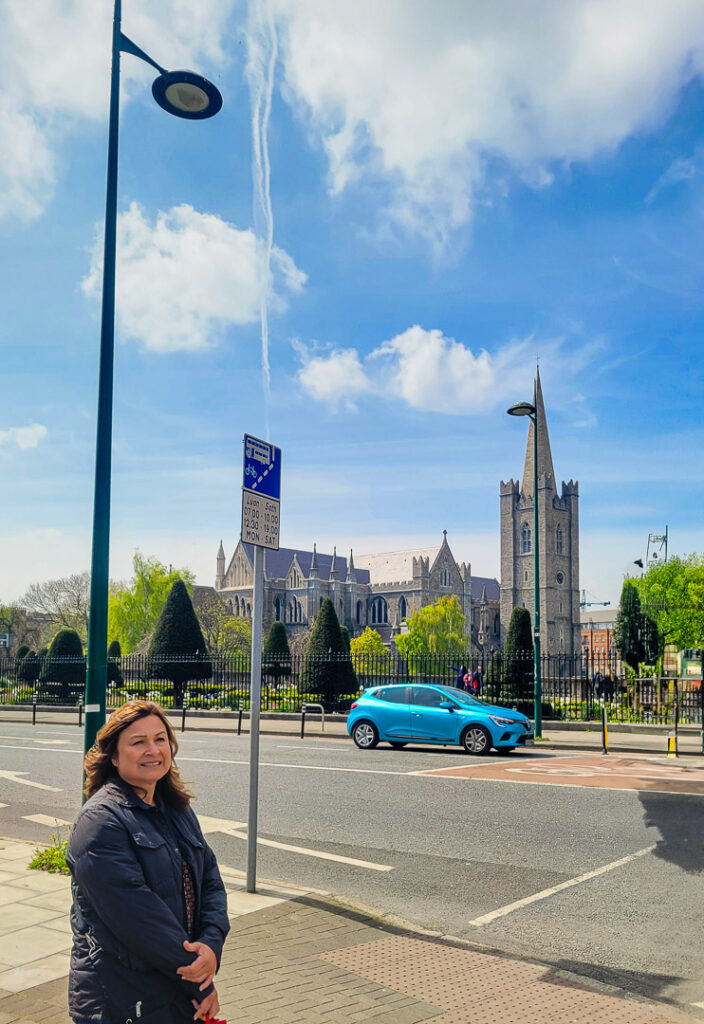
The Guinness Storehouse
It’s worth visiting the Guinness Storehouse for the experience alone, and the beer at the top. The Gravity Bar, with its floor-to-ceiling windows and 360-degree views of Dublin, offers a sweeping panorama stretching to the Dublin and Wicklow Mountains and across Dublin Bay. There are several tour options, but we chose the basic entry, which included a pint of Guinness. A simple, fun, and memorable stop.

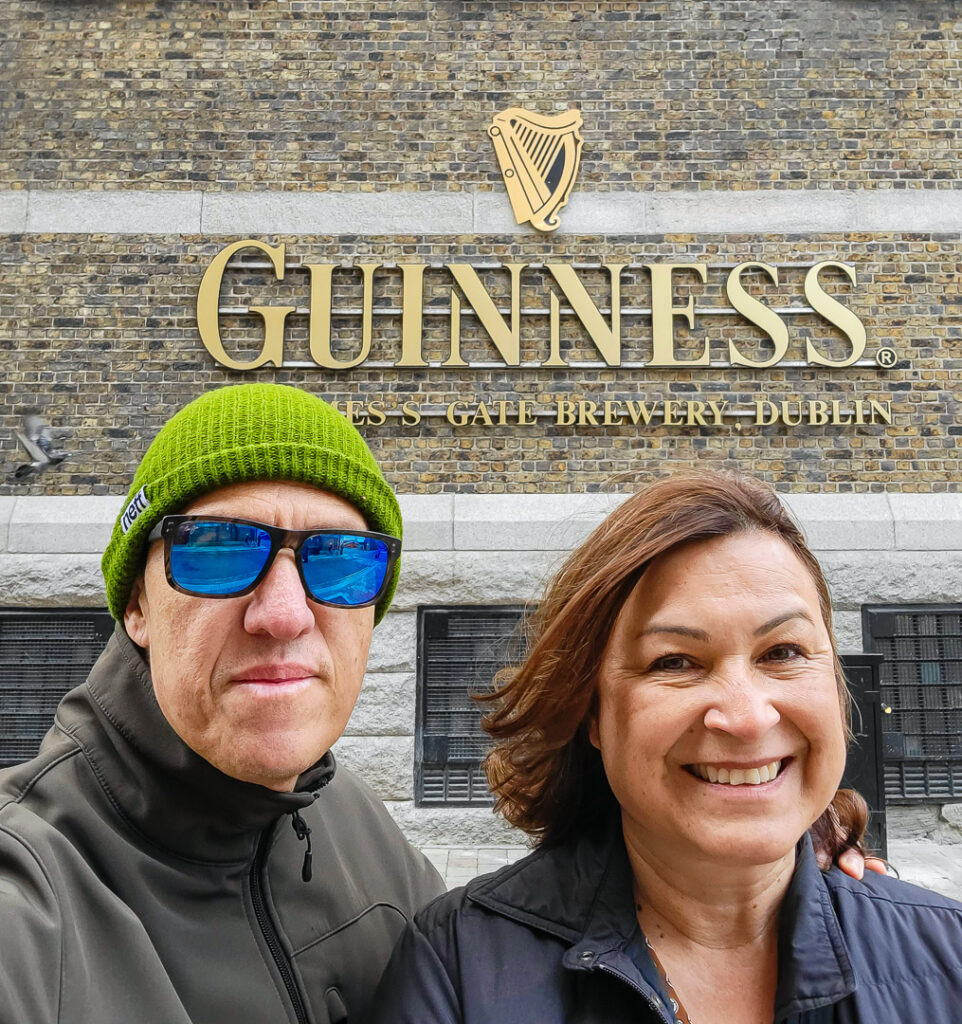
The Brazen Head – The Cultural Quarter
I wasn’t quite sure what to expect from The Brazen Head, but it turned out to be a well-worth-it experience. We enjoyed a traditional dinner while listening to stories of fairies, leprechauns, and the banshee; folklore that Ireland is famous for.
With full bellies and imaginations captured, we strolled toward the cultural quarter, taking in the vibe of the city night. The famous Temple Bar looked vibrant and lively, but a bit too touristy for our taste, so we decided to pass on going inside.

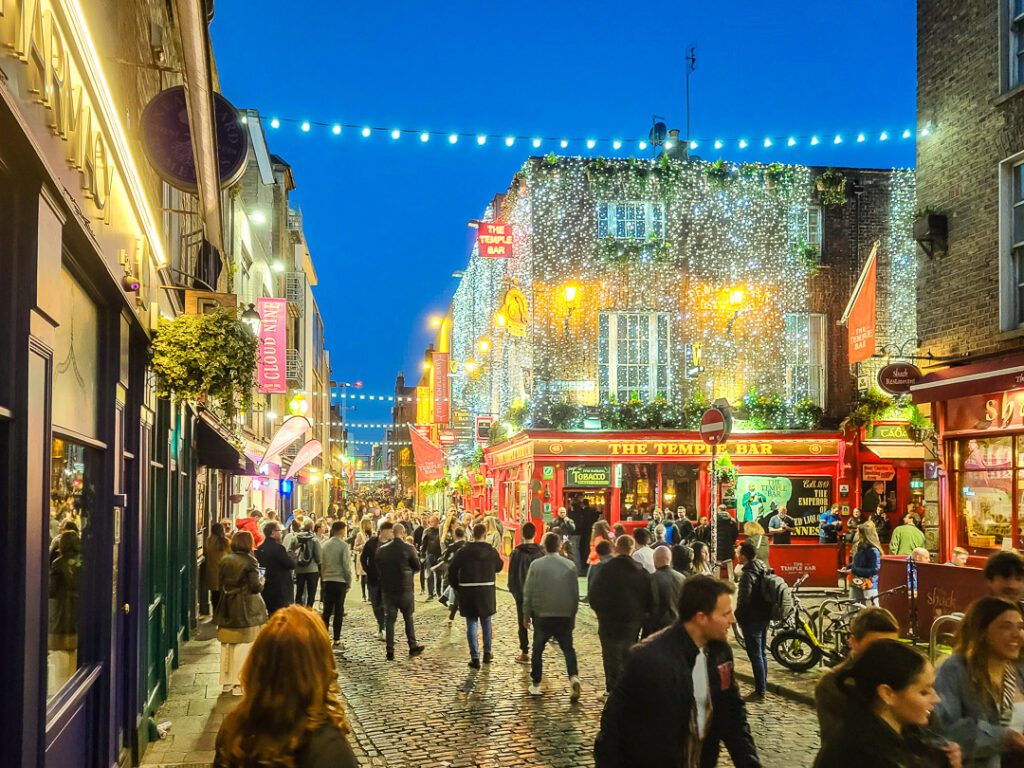
Rental Car – Rock of Cashel
Wrapping up our Dublin adventure, we made our way to the rental car hub. Our encounter with My Irish Cousin was exceptional, setting the perfect tone for our trip.
While driving a manual car wasn’t new to us, adjusting to the left side of the road, with the steering wheel on the right, shifting gears with the left hand, and the unfamiliar pedal work below, was undeniably nerve-wracking.
Everything you’ve learned about driving suddenly feels reversed, but you can’t overthink it; you just slow down and trust the rhythm of the road.

I’ll confess, though; the driving dynamic did spark some good-natured banter between my wife and me. Positioned on the left as the passenger, she’d occasionally holler about that I was getting too close to the left side of the road, yes, the left side that remains obstructed because I’m driving on the on the right side of the car. Nevertheless, we managed the challenge just fine in the end. Our road trip across Ireland had officially begun.
The Rock of Cashel, a commanding presence in County Tipperary, dates back to the 4th century. Also known as St. Patrick’s Rock, it has witnessed coronations, battles, and centuries of history. Walking the grounds of Celtic crosses, Romanesque chapels, and a looming round tower, felt like stepping back in time.
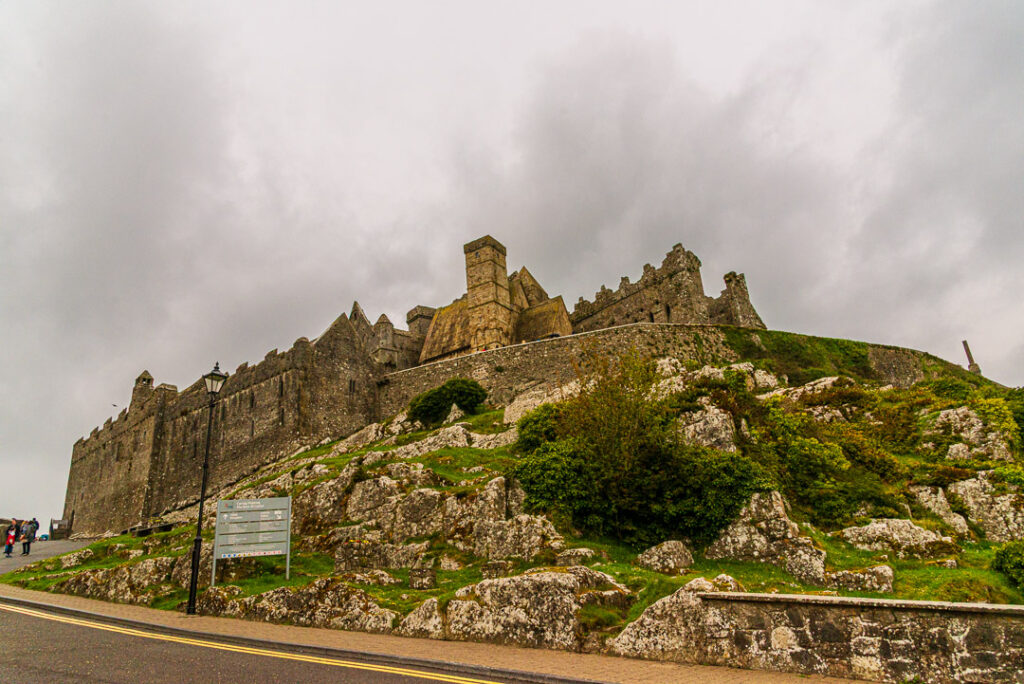




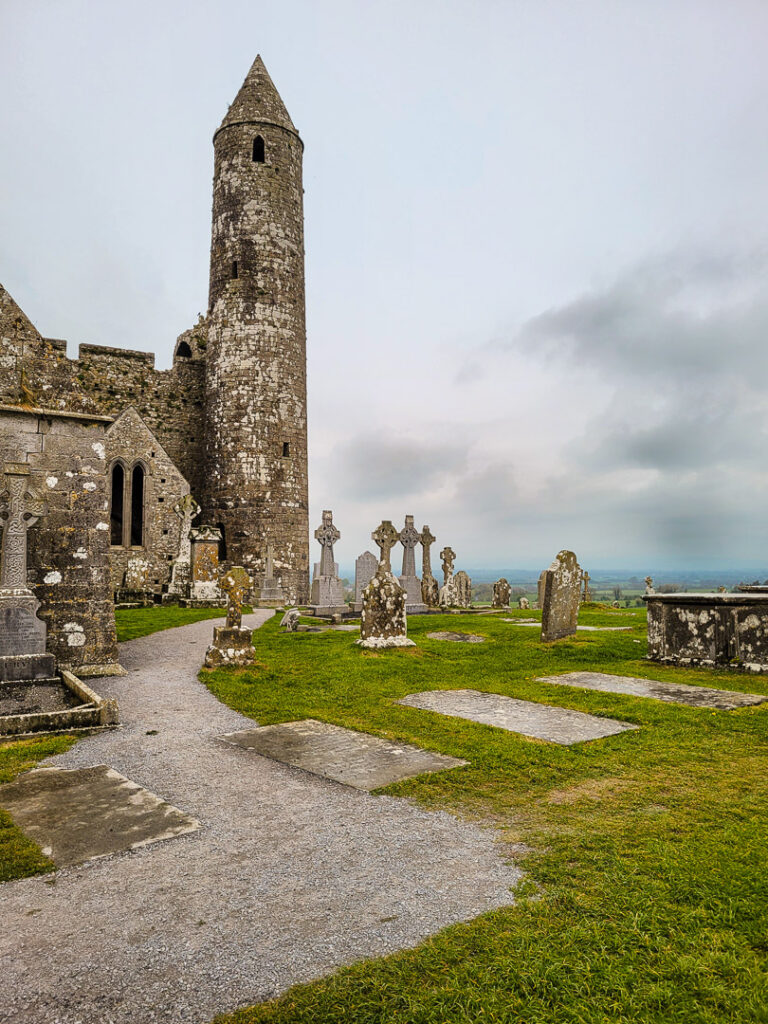
Shenanigans Walks – Kilkenny
We spent a couple of hours at Cashel before backtracking a bit to Kilkenny to meet up with Nevin Cody from Shenanigans Walks. The drive took us further inland, where we got to see the countryside, it’s every bit as beautiful as the coast. I had been looking forward to meeting Nevin in person, having researched him and his tours beforehand. He wears many hats; he’s not just a historian, but also a comedian, entertainer, and a true gentleman.
Our tour with him was an absolute delight, filled with fascinating historical insights, magic, and plenty of laughter. Highlights included Kilkenny Castle and the Black Abbey, known for its long history as a Dominican priory, its unique name derived from the black cloaks of the friars and its impressive stained-glass windows.
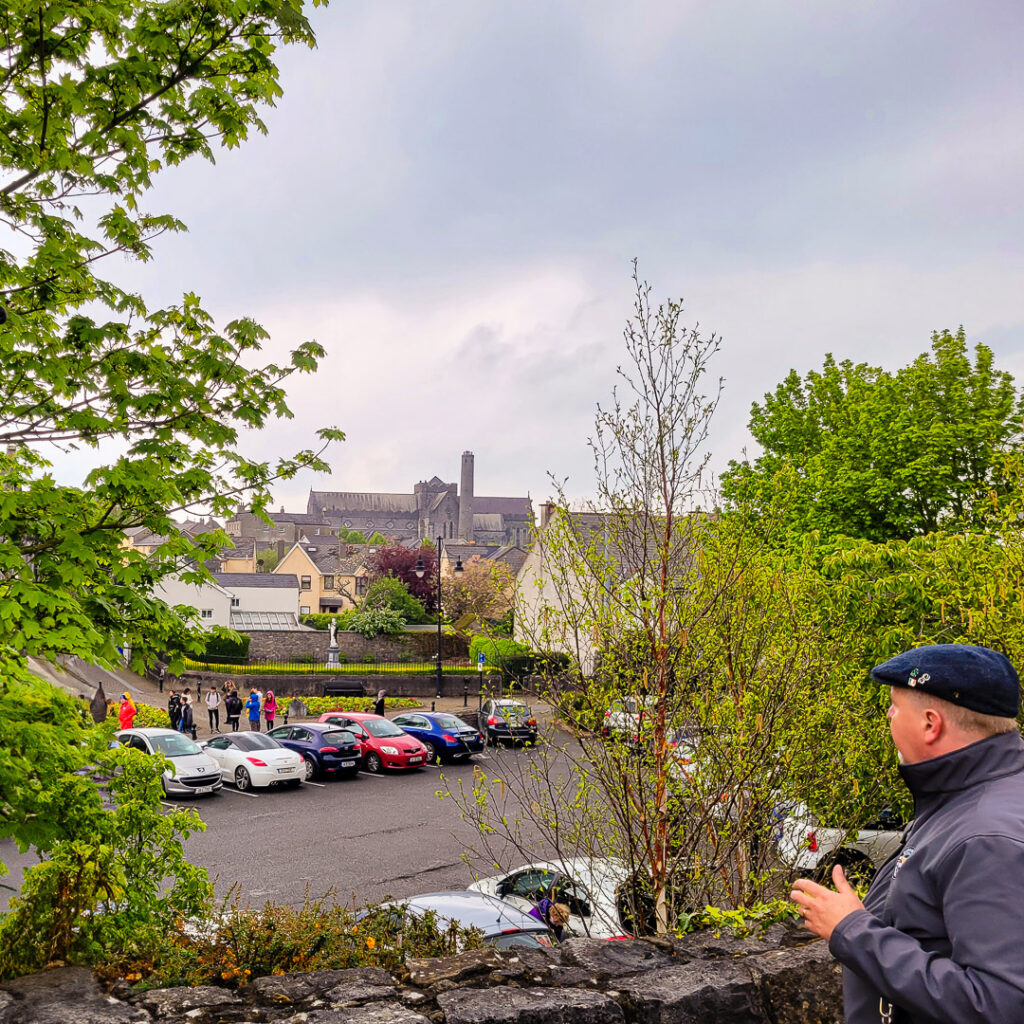


Kinsale
In Kinsale, we found color, warmth, and the sea. Our first B&B stay, was hosted by the gracious Philomena or Phil as she preferred to be called. Our experience here felt like being welcomed into the home of a favorite aunt. Every morning, she would prepare breakfast with the loveliest table setting. One morning, we sat with a couple from Germany and enjoyed the small talk, it was wonderful to meet and break bread with strangers.



We did our city walk with Barry Moloney from Historic Stroll Kinsale where he explained where the original shoreline from the strategic port used to be, showed us where medieval walls once stood and a how the Battle of Kinsale took place. Next, we walked through some fancy real estate towards the stone ramparts of Charles Fort, a star-shaped coastal fortress built in the late 17th century to defend the harbor, renowned for its striking design, historical significance, and panoramic views of the Atlantic. Kinsale’s downtown is very walkable, with some great shopping and restaurants.


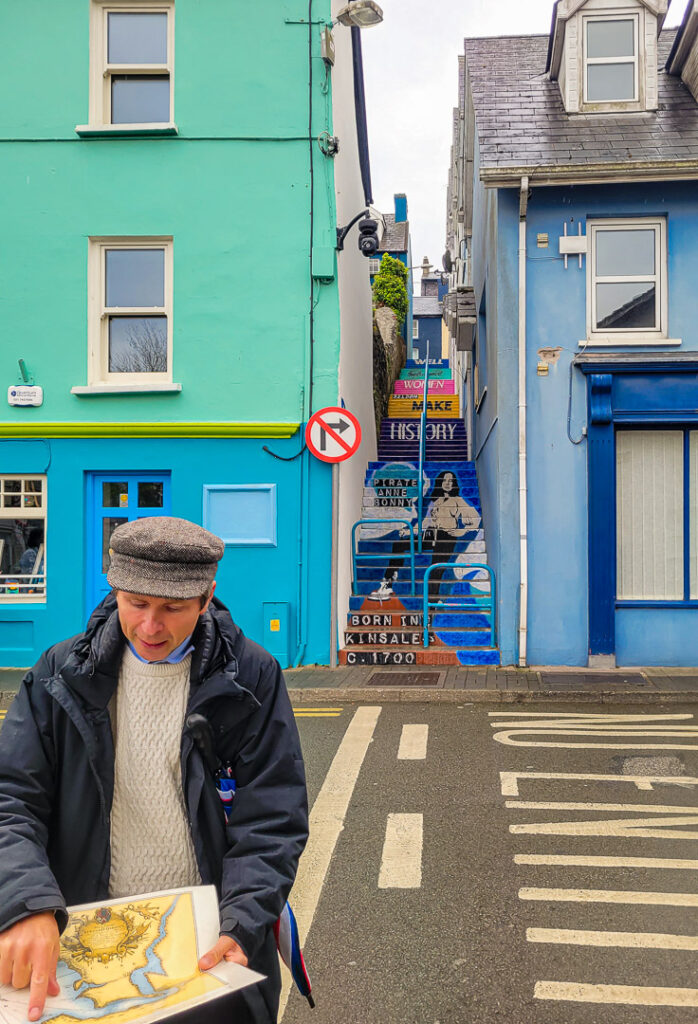



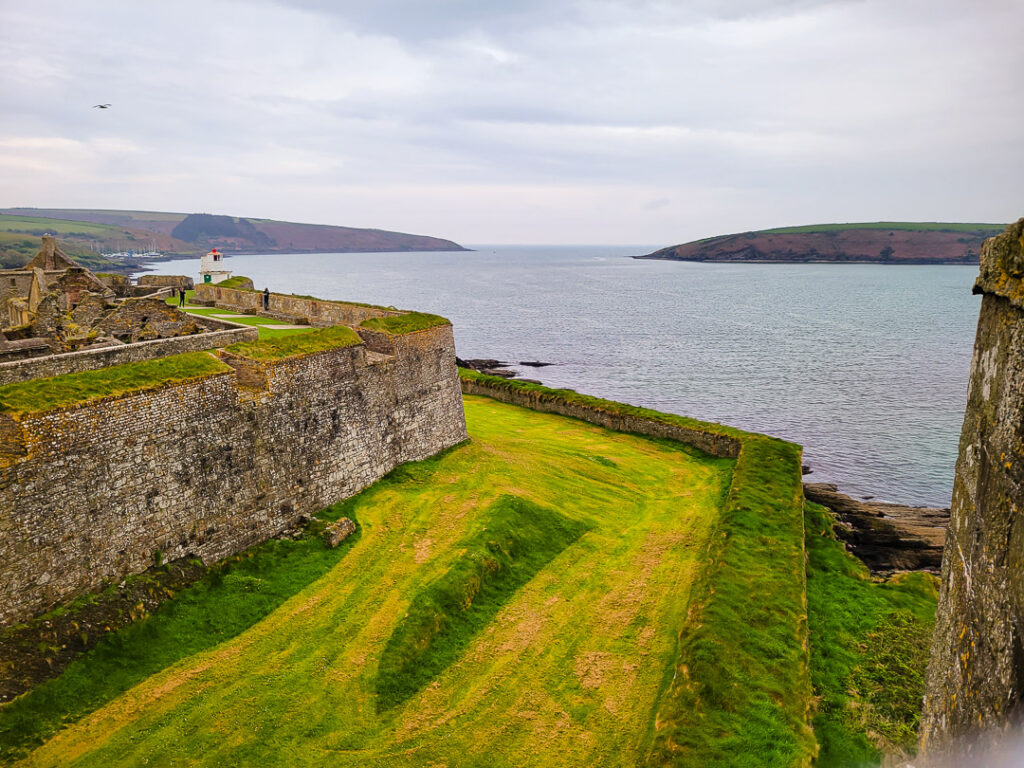




One of my favorite finds was at Mamukko, a workshop of artistry and imagination, where I discovered a travel bag and coin holder unlike any I’ve owned, both crafted from reclaimed sails, give yourself plenty of time to enjoy Kinsale and don’t forget to make reservations for the many restaurants in town. This was most challenging for us.


Drombeg Stone Circle, Killarney & Beyond
Saying slán to Phil was bittersweet, as she was such a sweet soul and brought us joy every morning during our breakfast encounters. But alas, we navigated towards our ultimate destination, Dingle. With some stops planned along the way, we drove towards Killarney and a quick stop at Drombeg Stone Circle. The Drombeg Stone Circle is ancient and consists of 17 standing stones. Excavations have uncovered an urn burial at its center, dating back to 153 BC to 127 AD. In 1957 and 1958, further excavations unveiled cremated bones within a deliberately broken pot, cloth-wrapped, and buried near the circle’s center.
While we didn’t locate anything ancient, we did get a sense of peacefulness. The location is pleasing to the senses, at the head of a long green valley, with a view that gently swoops down to the Atlantic ocean.


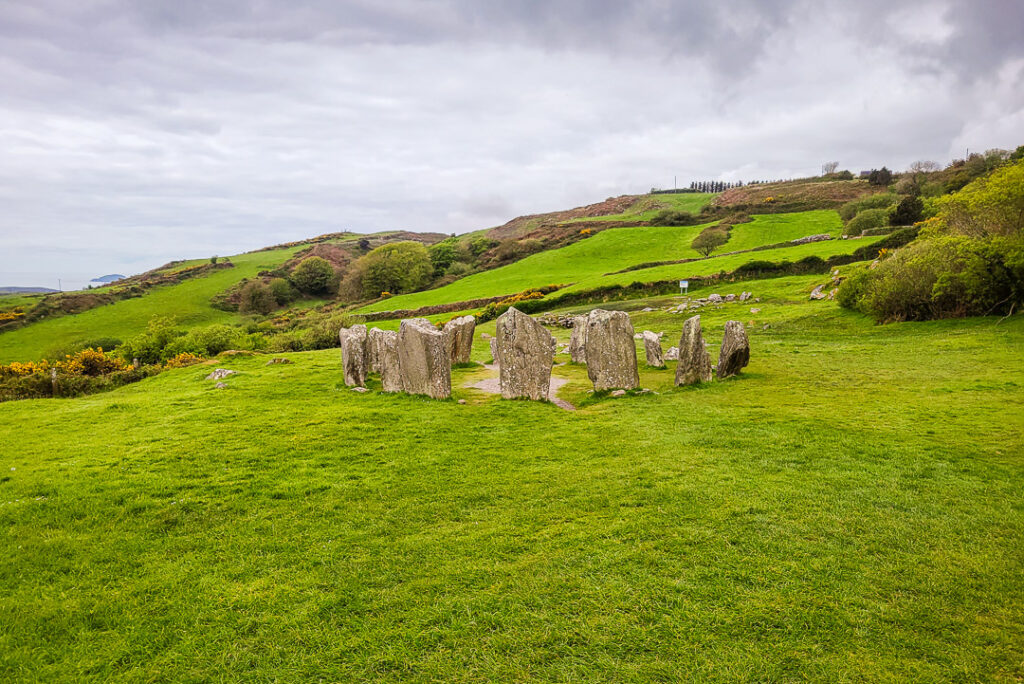
Killarney National Park was a breathtaking mix of lakes, mountains, and woodlands and some fascinating history, with the Muckross House, at its entry.
Built in 1843 for Henry Arthur Herbert and his wife Mary Balfour Herbert, the Tudor-style mansion was designed to showcase their wealth and status. Hoping to gain status with Queen Victoria, they invited thy royal highness and to prepare for her visit in 1861, the Herberts went all out with lavish renovations, but in the end, the costs, combined with poor investments, eventually bankrupted them and the estate was forfeited in 1898.
The estate then found a new owner in Lord Ardilaun of the Guinness family, who used it as a weekend hunting lodge. Later, in 1911, it was purchased by William Bowers Bourn, a wealthy Californian mining magnate, and his wife Maud Vincent. After a family tragedy, Maud’s parents and son-in-law generously donated the estate to the Irish nation in 1932, creating Ireland’s first national park.
I hear that the inside of the house is lavish and worth the tour. Unfortunately, we did not plan accordingly, but still enjoyed the outside of it. After a peaceful boat ride across the lake, we strolled along the shaded trails to Muckross Friary. In the heart of the courtyard stands a magnificent yew tree, its gnarled branches twisted with time. The exact age of the tree is unknown but estimates place it between 400 and 600 years old, some suggest it could be even older, linking it to the abbey’s 15th-century founding. It’s a breathtaking, living testament to history, faith, and the countless generations who have passed beneath its boughs.









Dingle
The drive into Dingle was beyond imagination; the rolling hills, deep valleys, and countless sheep created a landscape straight out of a W. B. Yeats poem. Unfortunately, I have no photos or videos; as we were focused on arriving before nightfall. But if you make the journey, take your time, this stretch of Ireland is absolutely stunning.
We stayed at the Lantern House, a quaint B&B with just the right touch of home. Our host, Anne-Marie, was wonderful, warm, accommodating, and attentive to every detail of our brief stay. We spent our time wandering through Dingle’s charming shops and were able to enjoy a delicious dinner at Out of the Blue, a seafood gem featured in the Michelin Guide for the past 15 years, and every bite proved why.






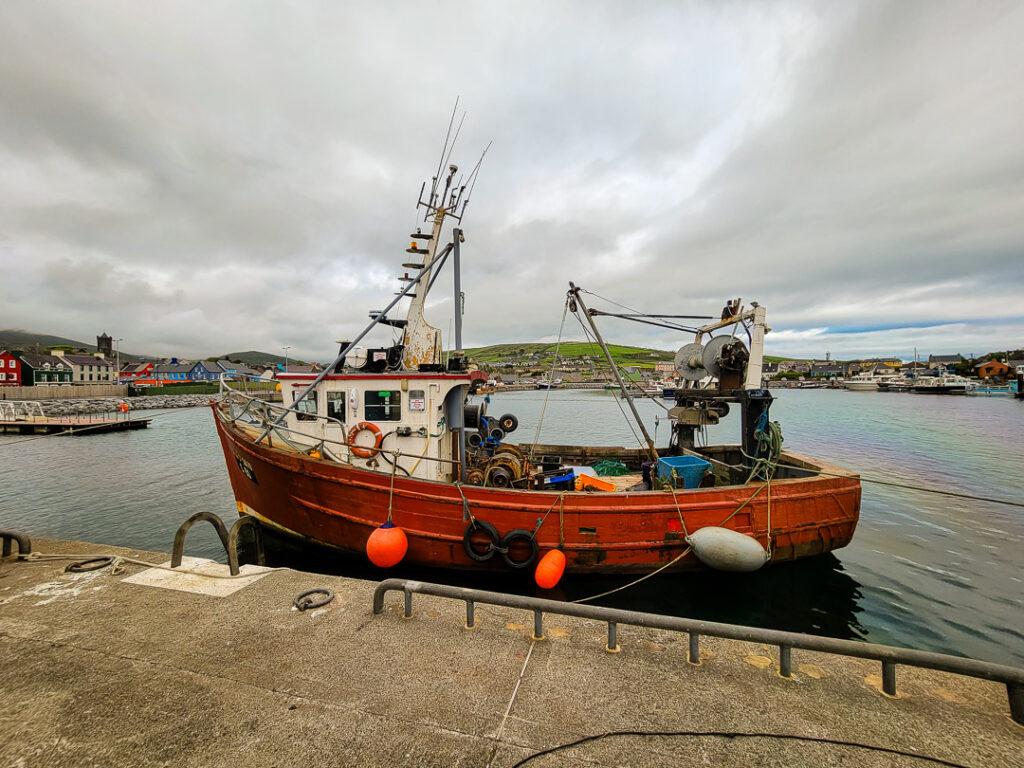
Slea Head Drive – The Fairy Fort & Dunmore Head
The Slea Head Drive on the Dingle Peninsula is one of those places that remind you why travel matters. Stretching just 24 miles along Ireland’s Wild Atlantic Way, the local name is known as Slí Cheann Sléibhe. This beautiful highway winds through rugged coastline, quiet villages, and landscapes that seem traveled, but untouched by time. Officially added to the Wild Atlantic Way in 2014, the drive still carries the texture of something much rustic and weathered.
Driving it clockwise kept us closest to the coast, which also meant hugging some tight turns along the left-hand side of the road. What amazed us, was watching the full-size tour buses handle those same narrow bends with ease. I have no idea how those drivers manage it, but they do, with what I can only describe as nerves of steel and a deep understanding of Irish roads.
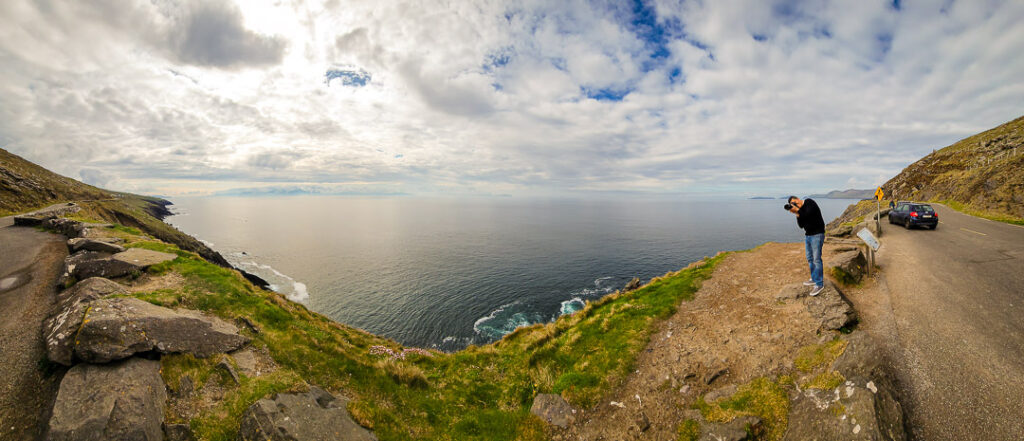
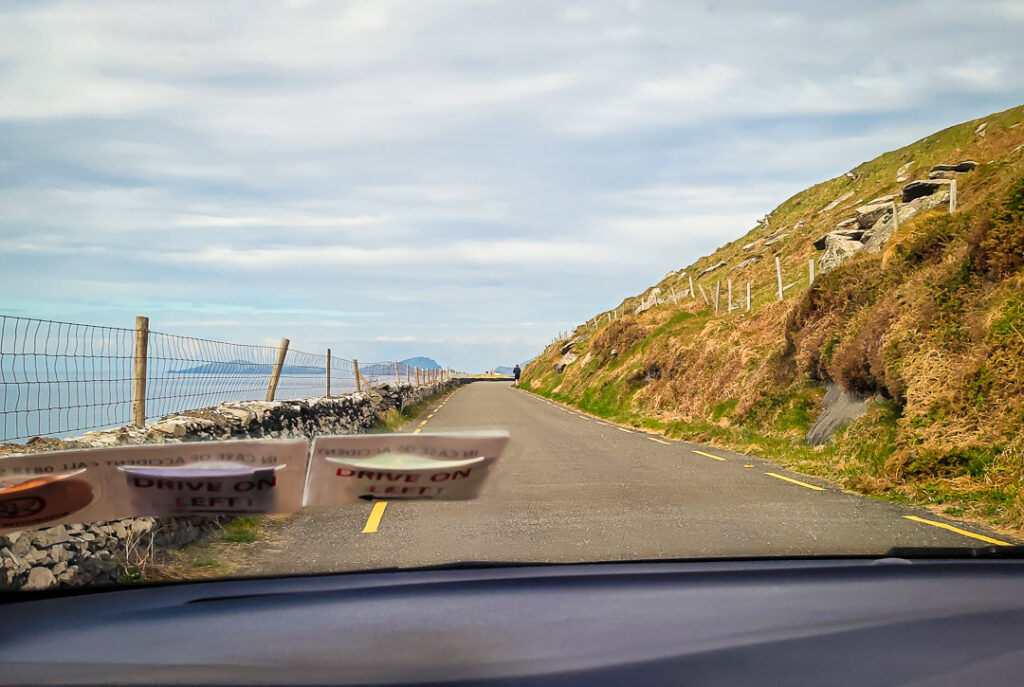
We stopped at the Fairy Fort, a small, pet farm that had baby sheep, lambs and donkeys running free. A really good experience being able to have them all walk up to you, looking for food, and allowing to be petted. Just beyond the pet farm sits a preserved rath, or ringfort, where ancient folklore is, don’t mess with it and leave it be or else.
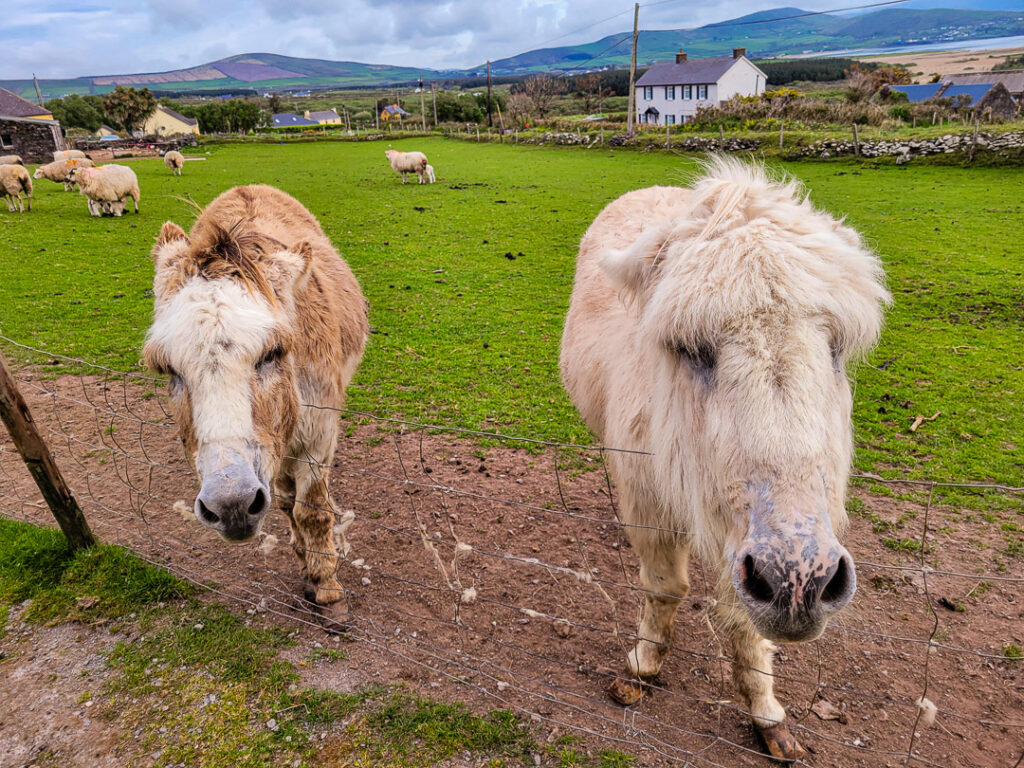


Just a bit up the road we stopped at the Bee Hive Huts, these ancient stone structures scattered along the hillside overlooking the Atlantic. Known locally as clocháns, the huts date back hundreds of years and were built entirely without mortar, each stone carefully stacked inwards to form a corbelled dome. Standing inside one, it’s hard to imagine how people once lived here, braving the harsh coastal winds with only layered stone for shelter. The stop was brief, but you really get a feel for how the locals lived, rugged.
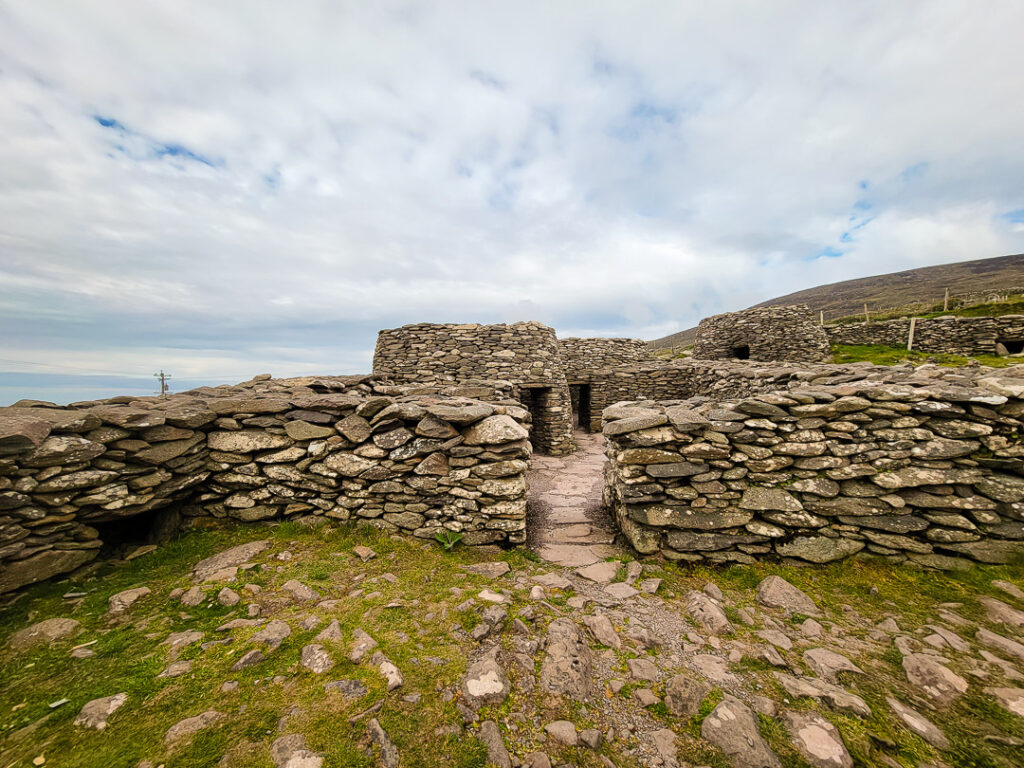
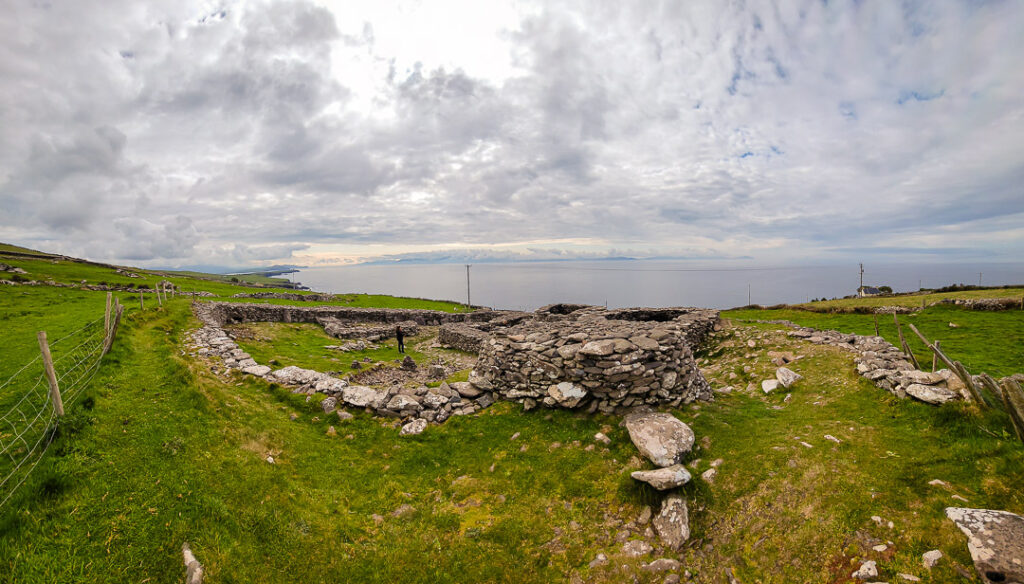




Our next stop was Dunmore Head, filming location for Star Wars: The Last Jedi, the land falls away into the Atlantic, and as soon as you get out of the car, the wind presses hard against you. Near the top of Dunmore Head stands a stone that has weathered fourteen centuries of Atlantic storms. The Coumeenoole Ogham Stone was discovered in 1838 lying on the ground and re-erected the following year. A small act of preservation that lets us read a message carved in the sixth century. The inscription, still legible despite everything the elements have thrown at it, reads “ERC MAQI MAQI-ERCIAS MU DOVINIA” – “Of Erc, son of Mac-Erce, descendant of the tribe of Duibne”.






Someone or some group of people honored Erc enough to carve his name into stone. We don’t know what kind of man he was, whether he was kind or cruel, whether he died young or old, whether his life mattered beyond his family. But someone wanted the world to remember he existed, that he was part of a lineage stretching back to Duibne. And here we are, fifteen hundred years later, still speaking his name. The stone sits just a kilometer from the Slea Head parking area, an easy walk connecting you to the top of the hill overlooking the Atlantic. Here is a detail explanation of the Ogham script
Heading to Galway – Conor Pass & Ferry Crossing
After our stay in Dingle and navigating Slea Head Drive, we set out for Galway, planning a stop at the Cliffs of Moher along the way. We chose the most scenic route out of Dingle, the legendary Conor Pass, one of Ireland’s highest and most breathtaking mountain roads. Winding through steep cliffs and glacial valleys, the R560 feels more like an adventure than a road, especially where it narrows to a single lane, hugging the mountainside with barely enough room for one car.
Before making the descent, we stopped at the overlook for one last sweeping view of Dingle and the surrounding bays. From the parking area, we watched other drivers navigate the tight, one-lane section below, holding our breath to see who would yield when two cars met in the middle. After a few nail-biting minutes, we finally worked up the nerve to drive it ourselves.

It’s not the fastest route from Dingle to Galway, but it’s easily the most dramatic. A white-knuckle, heart-stealing road that rewards every ounce of courage with unforgettable views. And yes, I can proudly say, we did it too! We continued north to catch the ferry from Tarbert to Killimer, then drove onward to our next destination: the iconic Cliffs of Moher.
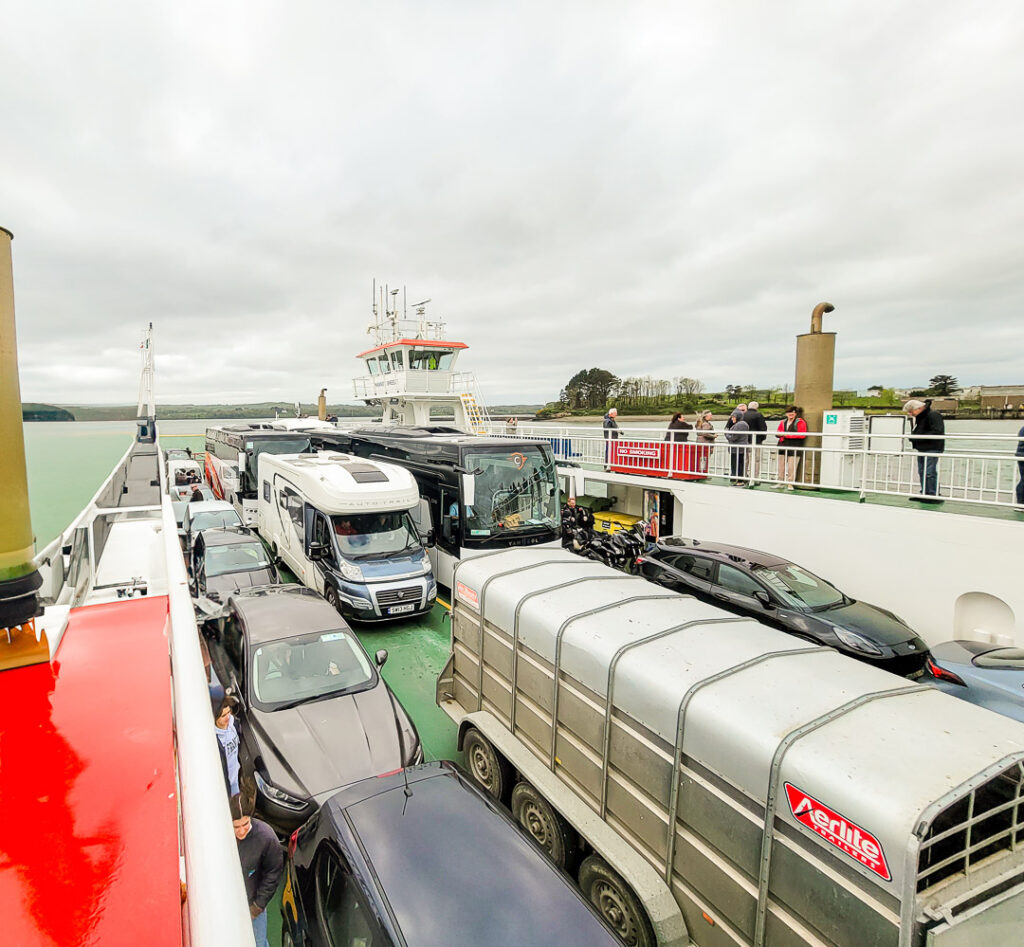

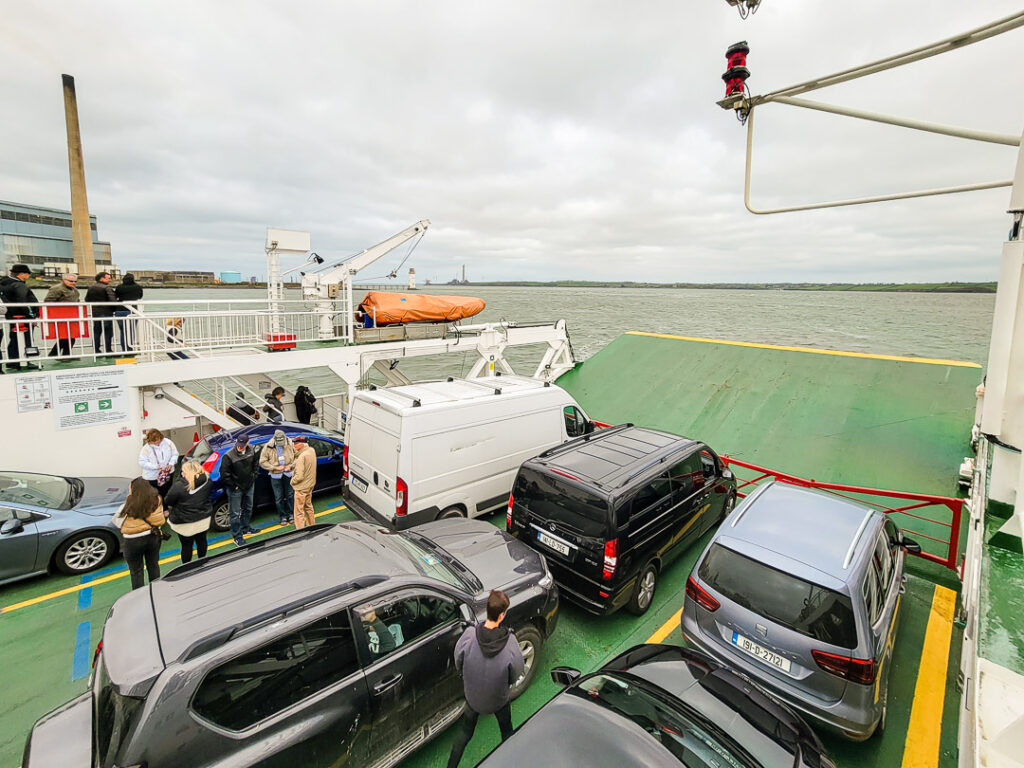
The Cliffs of Moher
Parking the car and walking toward the visitor center, there was no doubt we were about to experience something special. We had two options: take the easy 1-mile walk to O’Brien’s Tower or venture 3.75 miles to the southern viewing point known as Hag’s Head.
We chose Hag’s Head as it was farther, and far less crowded. With only a few other hikers along the way, we could actually hear the sea crash below and feel the wind push back as it blew all around us.
Hag’s Head marks the southernmost tip of the Cliffs of Moher, a rugged outpost with sweeping views and a rare sense of peace. The rock formation here is said to resemble a woman’s profile, from where I was, I did not see it. But there are other interesting rock formations to set your gaze upon.
Hag’s Head was home to an ancient fort called Mothar (or Moher), meaning “ruined fort” in old Irish. During the Napoleonic Wars, its remains were used to build Moher Tower in 1808, a stone watchtower guarding against Atlantic invasions.
In the 19th century, Cornelius O’Brien, a local landowner and MP, developed the northern section of the cliffs. He built walkways, viewing areas, and the now-famous O’Brien’s Tower to make the site more welcoming to visitors. But the southern stretch toward Hag’s Head remained as it was.
If you visit, take your time. The wind will whip around you, the sea will roar below, and you’ll understand why this corner of Ireland feels almost mythical. And for Harry Potter fans, the Cliffs of Moher made a cinematic appearance in The Half-Blood Prince. Check out the link for a good write up of The Horcrux cave scene filmed here and blended with Lemon Rock, a nearby island, using CGI.

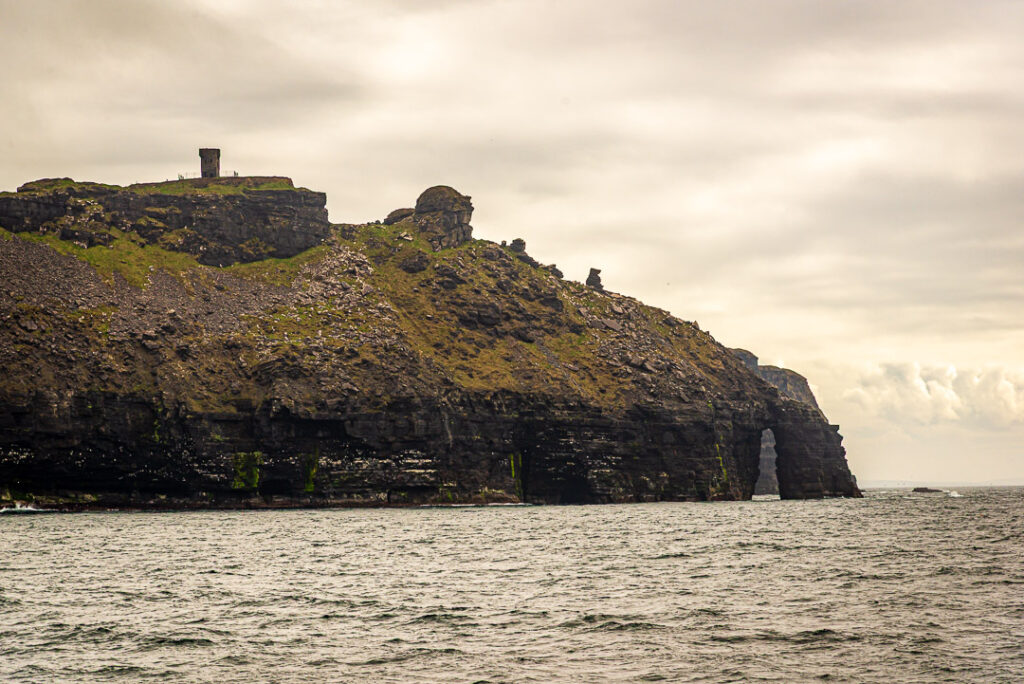

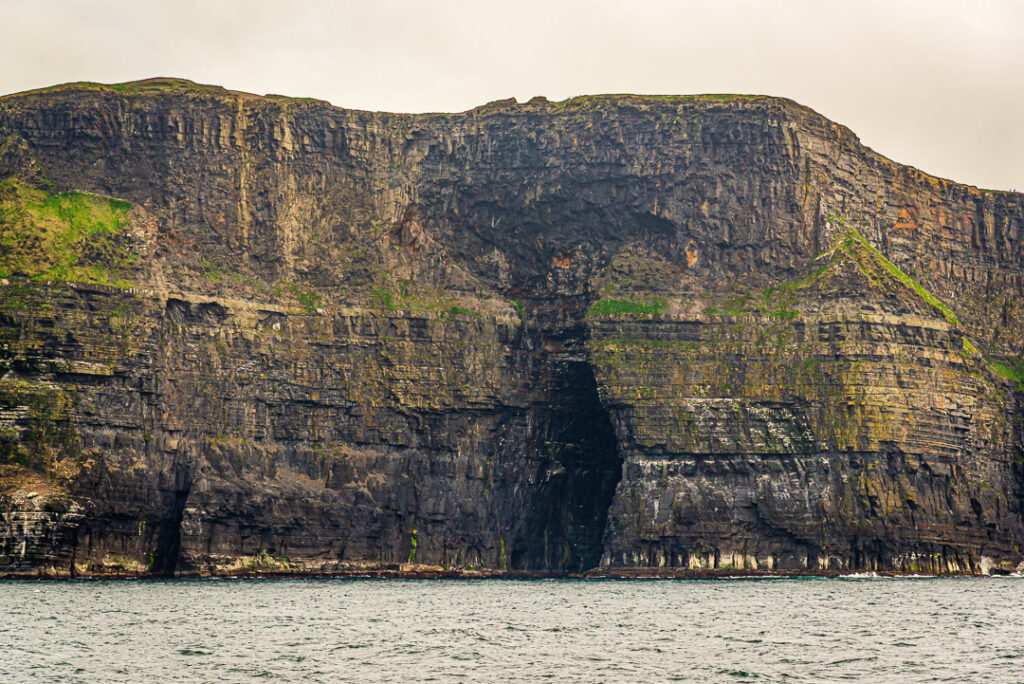



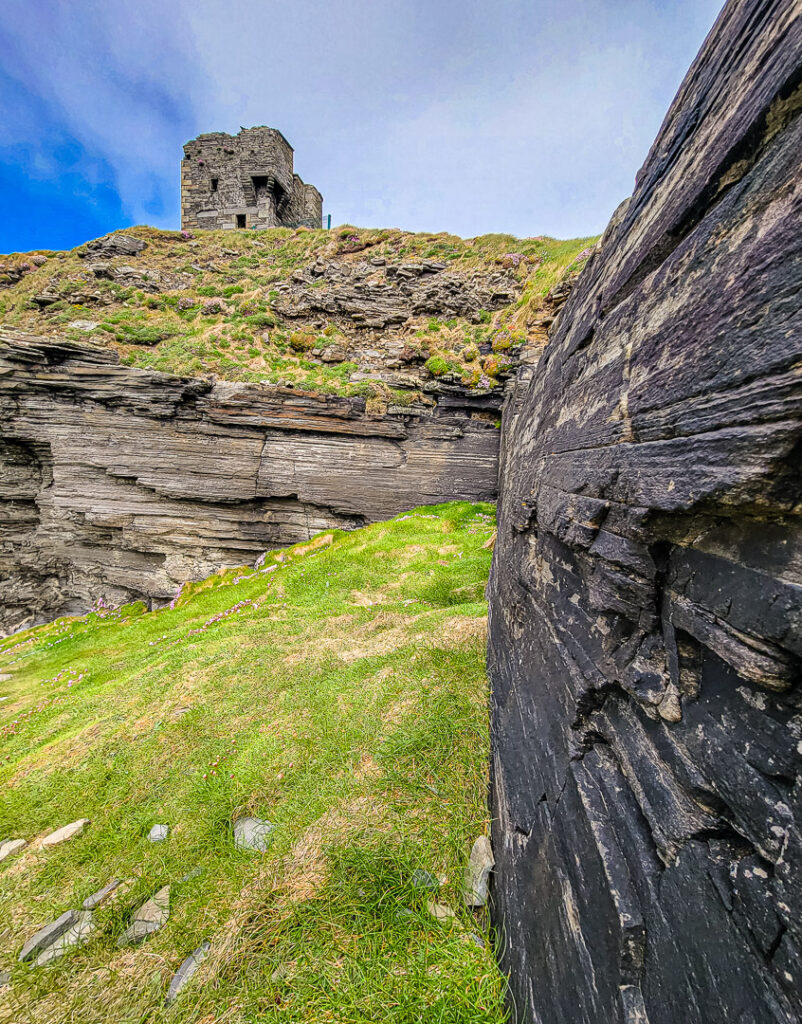

Galway
I had expected Galway to be a small, quiet town, but it was the complete opposite. Galway is actually the sixth-largest city on the entire island of Ireland. In 2022, about 85,910 people lived there, so driving into the city presented some challenges. First, there was the busy traffic to navigate (with locals who clearly had the home-field advantage), and second, finding the hotel’s designated public car park. Sigh.
We stayed at the Eyre Square Hotel, right in the city center and just a short walk from Eyre Square and nearby shopping areas. We enjoyed riverside walks along the Corrib, strolled under the Spanish Arch, and explored the Galway City Museum. One of the highlights was wandering through the Latin Quarter and eating the best fish and chips at McDonagh’s – yummy!


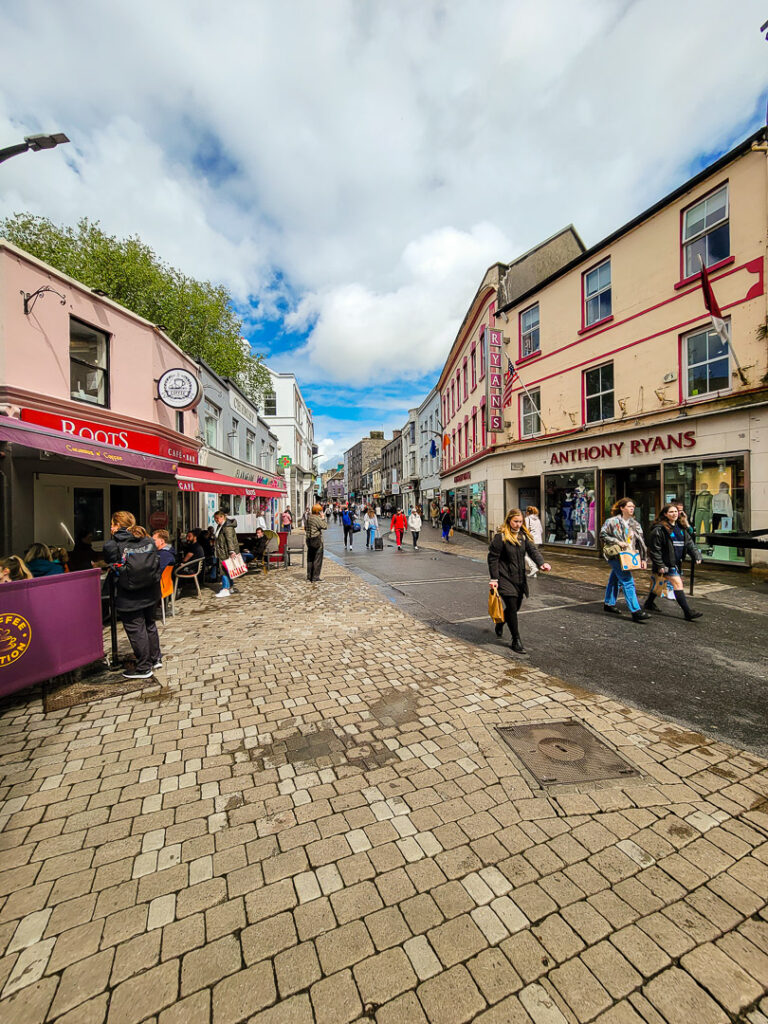

Inis Mór
We also booked a ferry to the Aran Islands and visited The Black Fort, or Dún Dúchathair, on Inis Mór. Unfortunately, Angie didn’t fare well with the sea crossing. Once we arrived, and disembarked, we were greeted by locals renting bikes to get around the island. They kept asking if we wanted e-bikes, but I was like, “Nah, we’re good.” Big mistake. I regretted that decision for the rest of the day; and Angie kept reminding me, why we did not get the e-bikes? It’s not a flat island!
While pedaling toward Dún Dúchathair (Black Fort), we had to pull over to let a car pass. While stationary on the bike, next to a briar bush, I couldn’t get my leg down to the ground quickly enough and toppled right into it. I ended up with a few scratches and some thorns in my hand, but honestly, the only thing that really hurt was my pride.

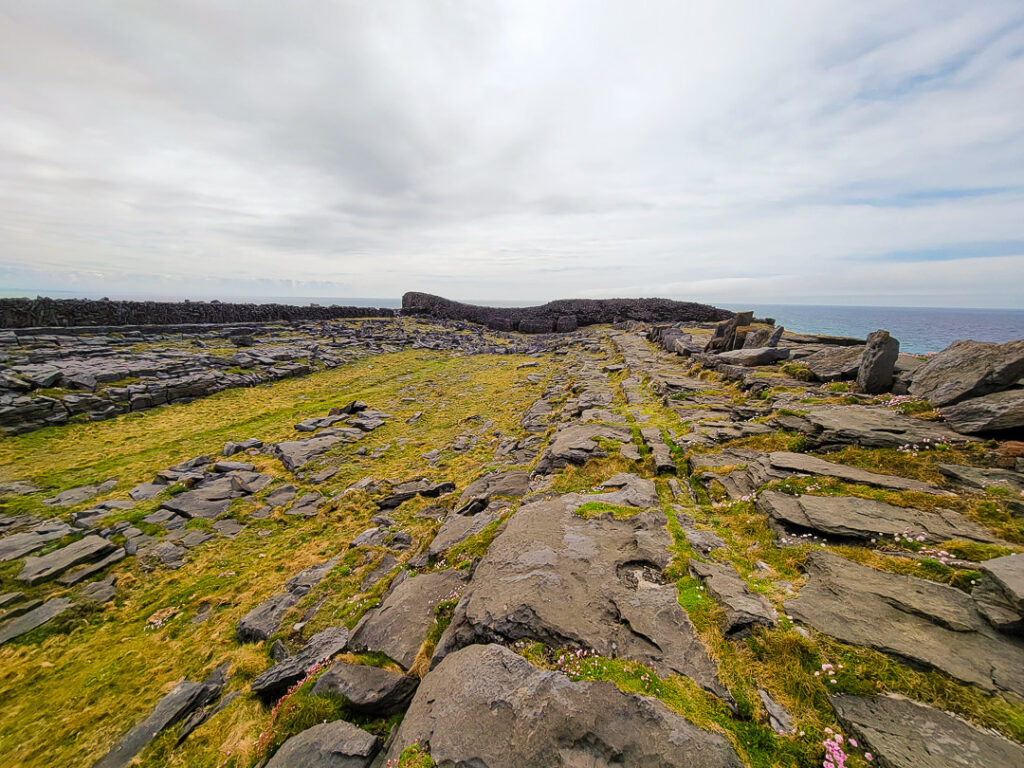

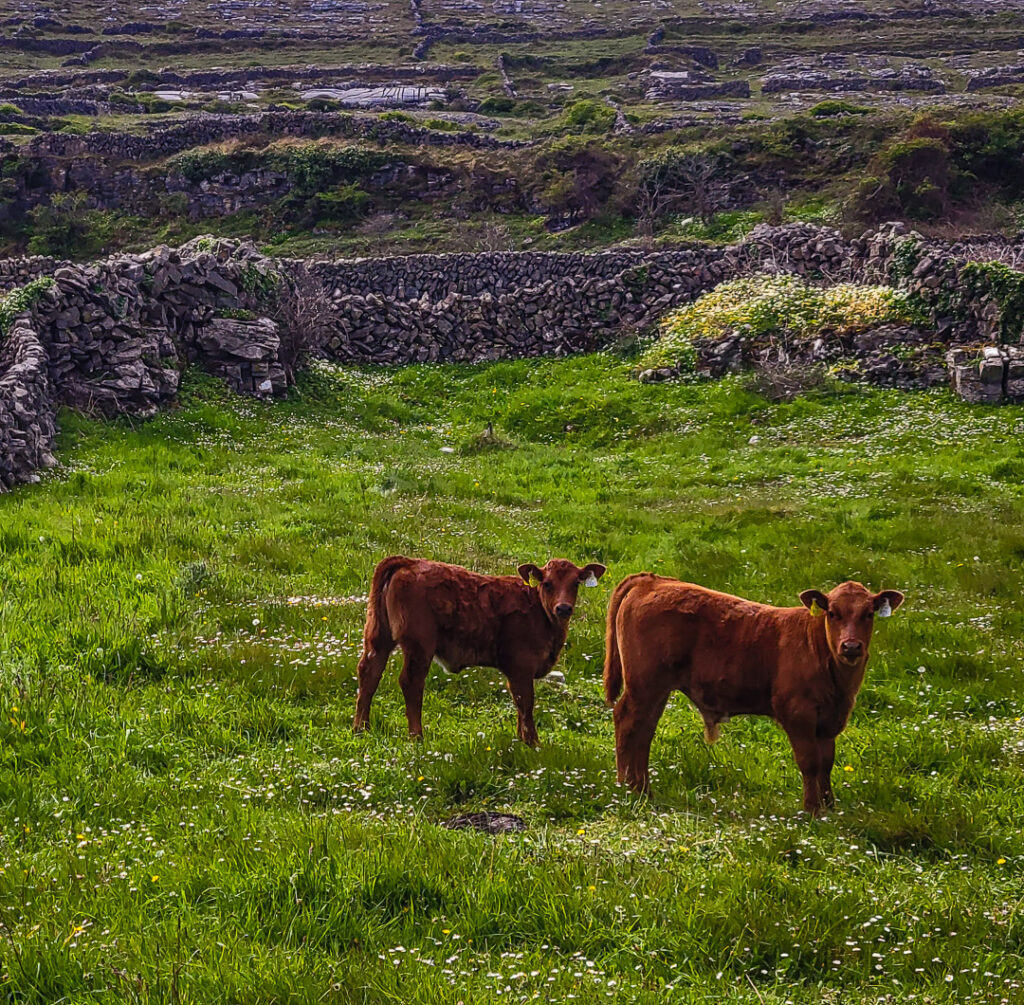



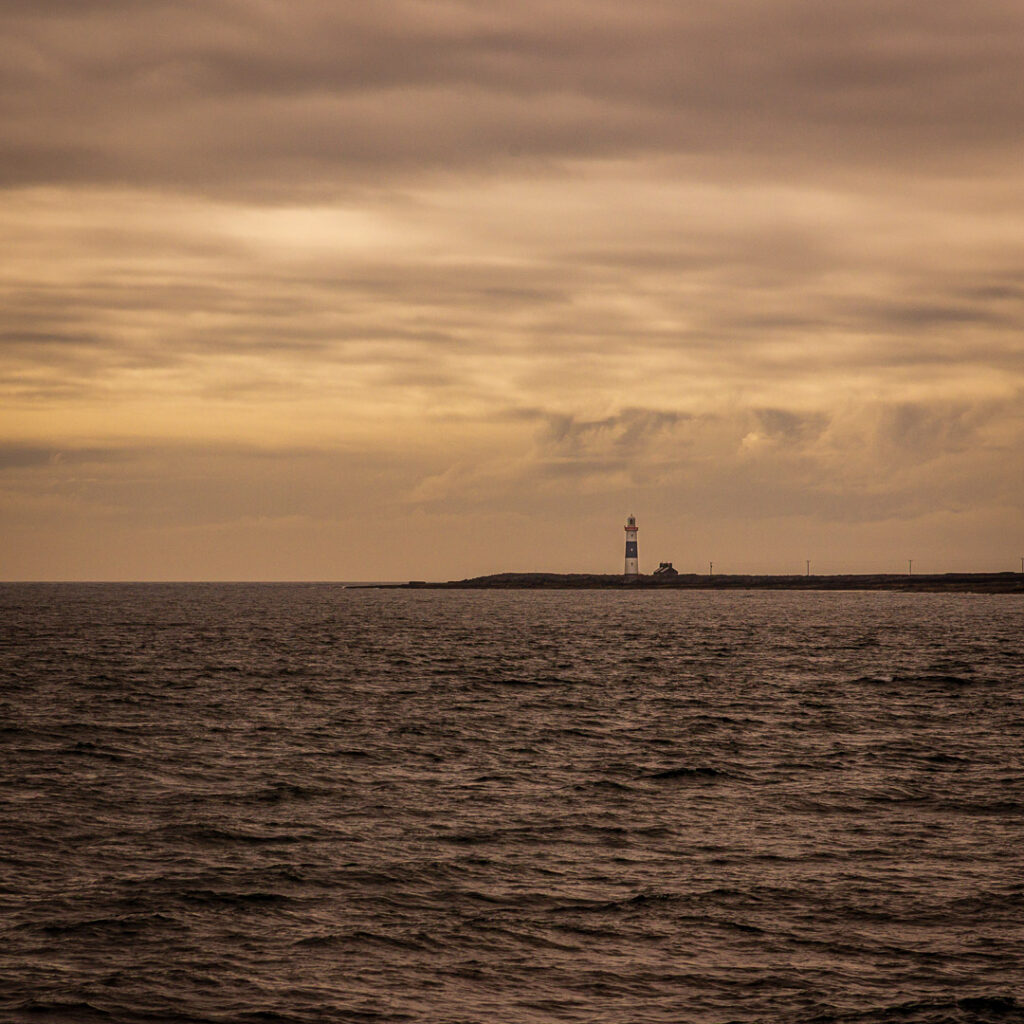
After returning from our day at sea, we visited the Galway Cathedral, a massive structure built in 1965. Unlike older cathedrals built on sacred ground, this one stands on the site of a former prison. Bishop Mícheál Browne oversaw its construction, resulting in an architectural marvel that blends Gothic, Renaissance, and Romanesque styles.

O’Connor’s Pub
To wrap up our stay in Galway on our last night, we decided on a 30-minute walk to O’Connor’s Pub in Salthill. We arrived right at opening, which gave us a chance to sit down and take in the place before the crowds rolled in. As the late afternoon turned into night, that place came alive; I can see why Ed Sheeran filmed “Galway Girl” there. Good times indeed. By the end of the night, I’d had way too much to drink… and then came the long walk back, totally worth it!


The Quiet Man Bridge
The next morning, considering the amount of Hop House Lager I’d consumed the night before, I was surprisingly functional and even managed to get us checked out of the hotel in record time. Our plan for the day was simple: make our way toward Connemara, with a quick stop at the Quiet Man Bridge. As fans of the classic film, we couldn’t pass up the chance to see it in person. If you’re a fan too, here’s a great resource that highlights the different filming locations used throughout Ireland.

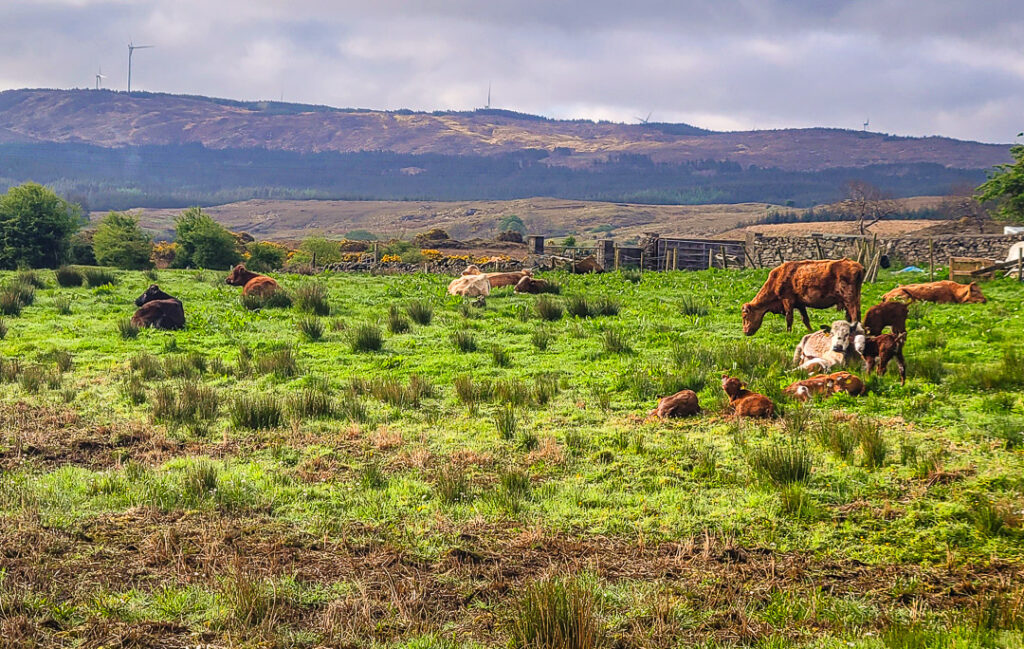



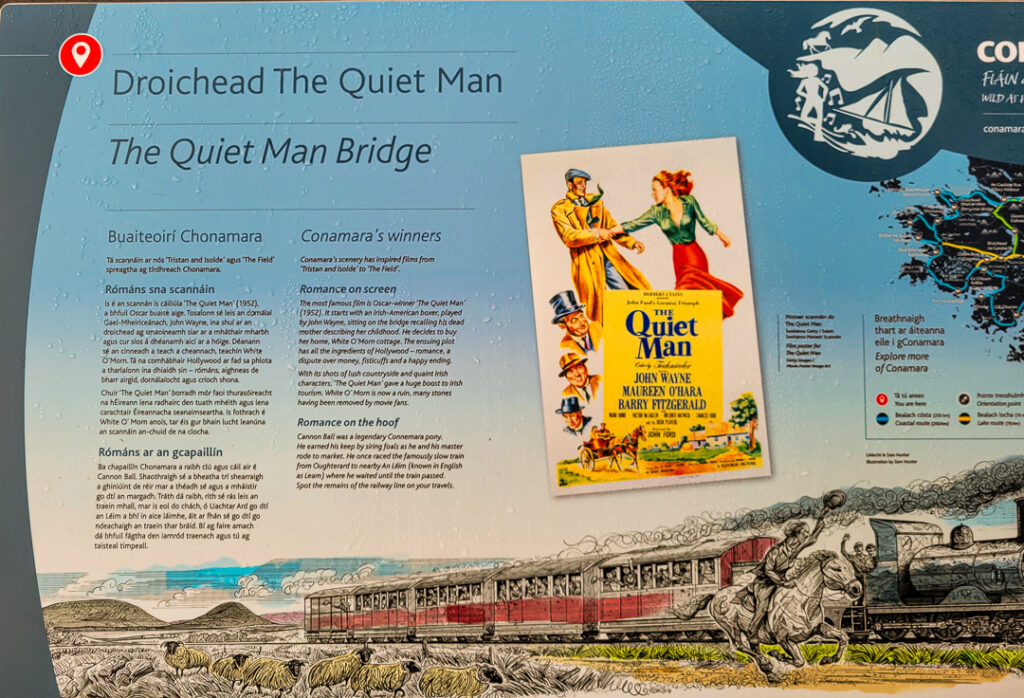



Kylemore Abbey
If only I’d had a GoPro mounted on the dashboard. The drive into Connemara National Park was pure magic. The N59 wound its way along Kylemore Lough, every curve revealing another postcard-worthy view. Not a single car passed us, just herds of sheep lazily grazing by the roadside as if they owned it. I was behind the wheel, so these were the only two that I took from the morning.


Our next stop was Kylemore Abbey, and it truly took our breath away. The castle sits at the base of a mountain, and on a still day, it’s perfectly mirrored in the lake below. Built between 1863 and 1868, it was the dream home of Mitchell Henry, a wealthy English politician, and his wife, Margaret. Their love story ended too soon as Margaret passed away in 1875, and Mitchell spent little time at Kylemore afterward. Today, the two rest together in a small mausoleum on the grounds, a quiet reminder of devotion and loss.
In 1920, the estate became home to Benedictine nuns who had fled Belgium during World War I. They brought new life to Kylemore, founding a boarding school for international students, a day school for local girls, and even running a working farm and guesthouse. The guesthouse closed after a fire in 1959, but part of the property remains a private sanctuary for the nuns’ monastic life of prayer and work. It’s a place steeped in history, for sure.

Connemara National Park
A few miles further down the N59 brought us to Connemara National Park, where Diamond Hill was waiting for us. We laced up our hiking boots, tightened the straps, and set off on the Upper Trail, a 3.8-mile (6 km) loop that climbs steadily toward one of the best viewpoints in all of Connemara.
The path is well-marked with stone paths and wooden steps. The hike is steep in some sections, and your legs will burn just enough to remind you that you are earning the view. As we climbed higher, the views open up beautifully with rolling hills along with the Twelve Bens rising proudly in the distance, and far below, the glimmer of Kylemore Abbey framed by the lake. At times, you’re eye level with the birds as they glide past.
At the summit, the reward was indescribable. A 360-degree panorama stretched out before us; lakes, valleys, mountains, with blue sky and shifting clouds. On the descent, the trail curved back toward the visitor center, where sheep grazed lazily across the open fields, completely unbothered by the hikers passing by.
Connemara was one of my favorite stops and hope to return someday, there is serenity about it, that words just can’t describe.







Westport
Meh, Westport was okay. It was a recommended place to visit by Rick Steves, but it struck me as an affluent area that lacked the traditional Irish charm we’d experienced in other towns. While Westport certainly has its share of history and attractions, we just weren’t wowed by it.
Amusingly, the highlight came years later when we were watching Irish Wish with Lindsay Lohan and recognized Westport, especially the bookstore scene. We actually went inside during our visit and purchased a book on Irish history. Another fun fact: we visited in May 2022, and filming for the movie took place that September, weird coincidence.
Whether you enjoy Westport ultimately depends on your personal preferences and interests. Of course, everyone’s experience is different, so your visit might offer another perspective.



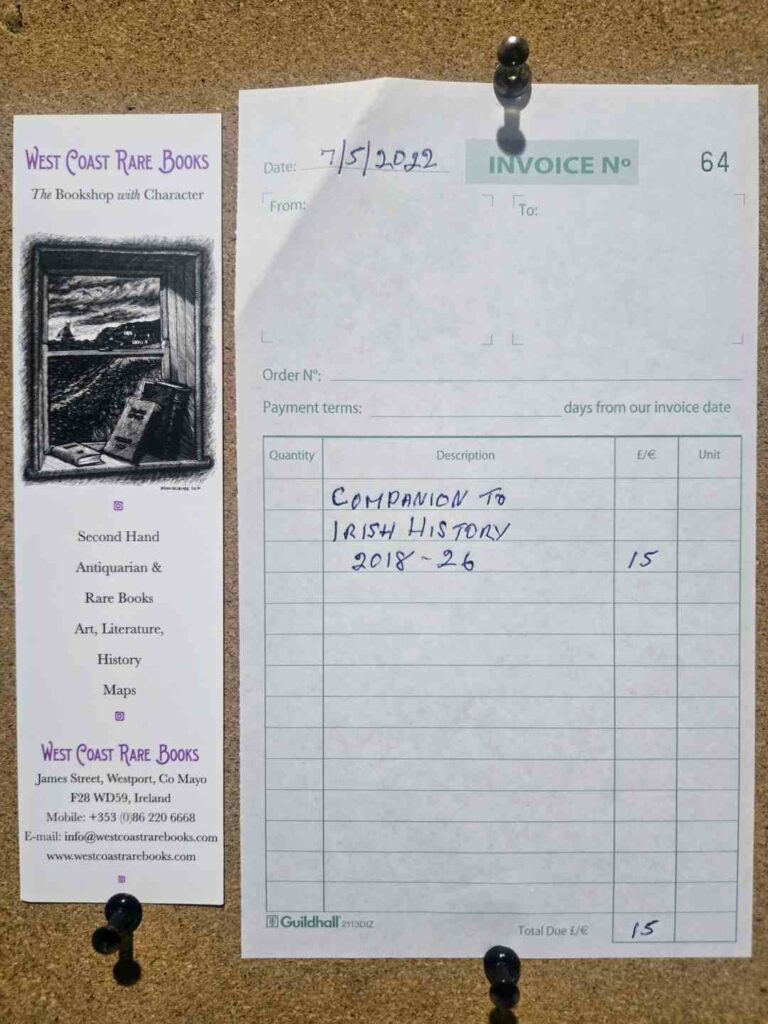


Donegal – Giant’s Causeway
The trip from Westport to the Giant’s Causeway took about two and a half hours, and Donegal wasn’t a planned stop. But after a long drive, we needed to get out and stretch our legs. We found a car park by the River Eske and had a pleasant chat with a local who joked that he wasn’t sure if the shorts in his drawer would still fit since he’d never had a chance to wear them. The weather that day was unusually warm, and the locals were enjoying every bit of it. After a nice walk through a few different streets, we made our way back to The Diamond for some coffee and pastries at Little Mamas. The town had an easygoing charm and made for a perfect spontaneous stop before continuing toward our final destination.
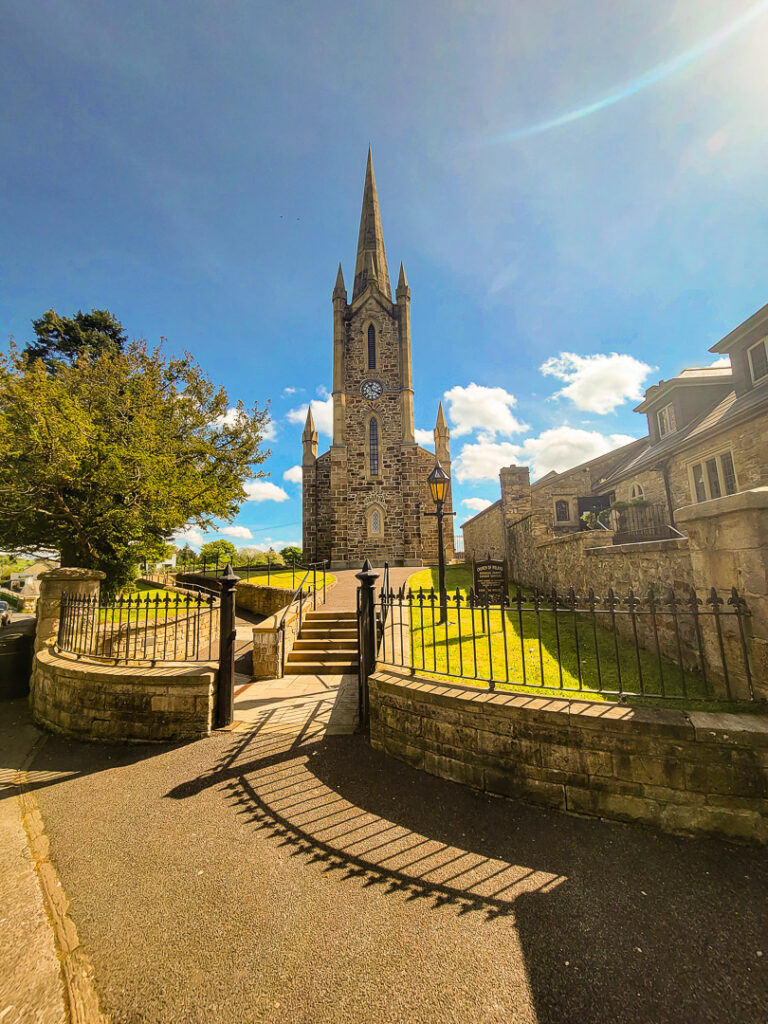




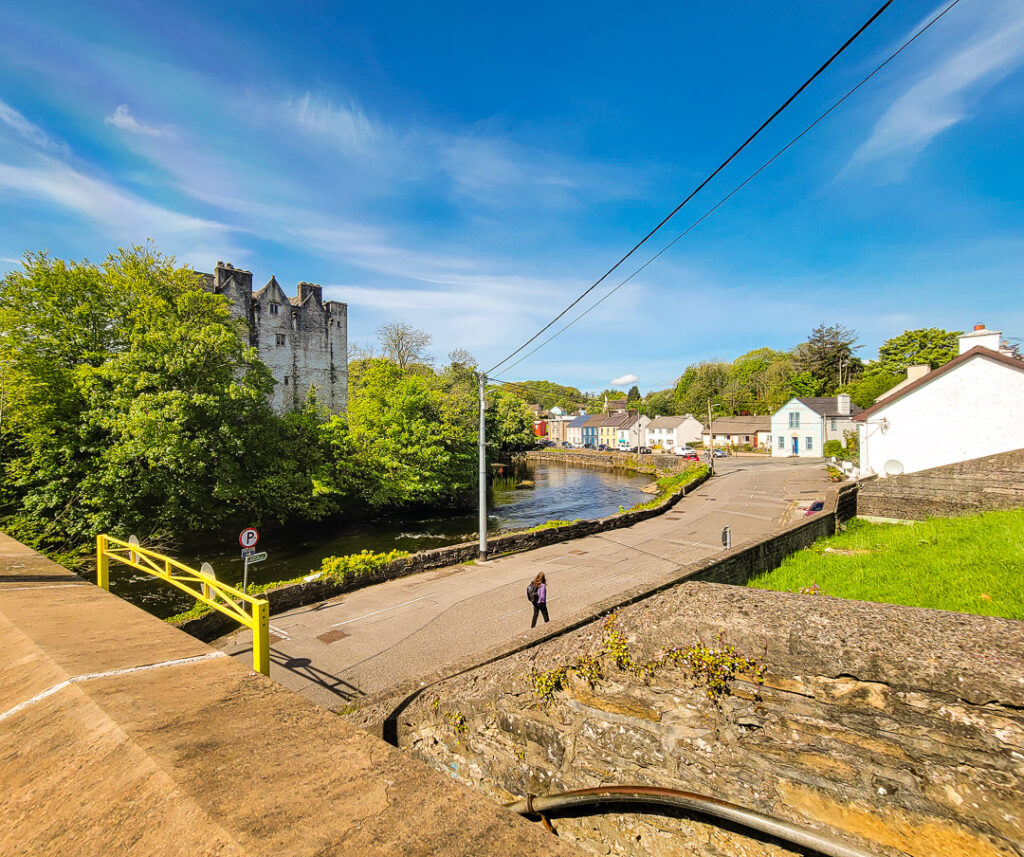

With caffeine and some sweets, we make our way back to the car park and realize that our Ireland travels are winding down. With just two stops left, thoughts of returning home to the daily grind start to creep in and the eventual return to the grind and mechanics of everyday life. But as the road stretches ahead, we push them aside and continue north toward the Giant’s Causeway in Northern Ireland, UK. Crossing the border was uneventful, just a sign “Welcome to Northern Ireland”
We had been looking forward to our stay at the Giant’s Causeway Hotel, and we were pleasantly surprised by its location. It sits conveniently right next to the entrance of the UNESCO World Heritage Site, of the Giant’s Causeway. The visitor centre is just steps away from the start of the walking path to this natural wonder of the world. We really enjoyed our stay here, especially the breakfast window table. Great hotel that has been welcoming travelers since 1836, offering a front-row seat to these amazing, world-famous stones. This place is a must see!
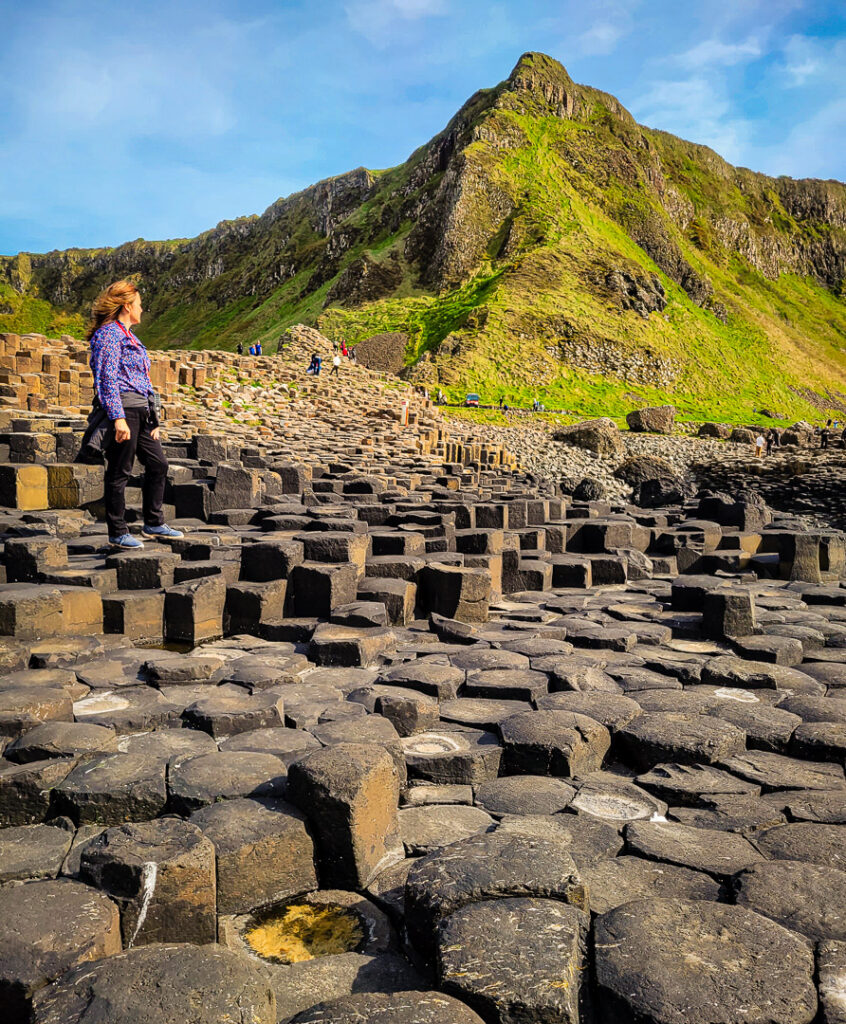


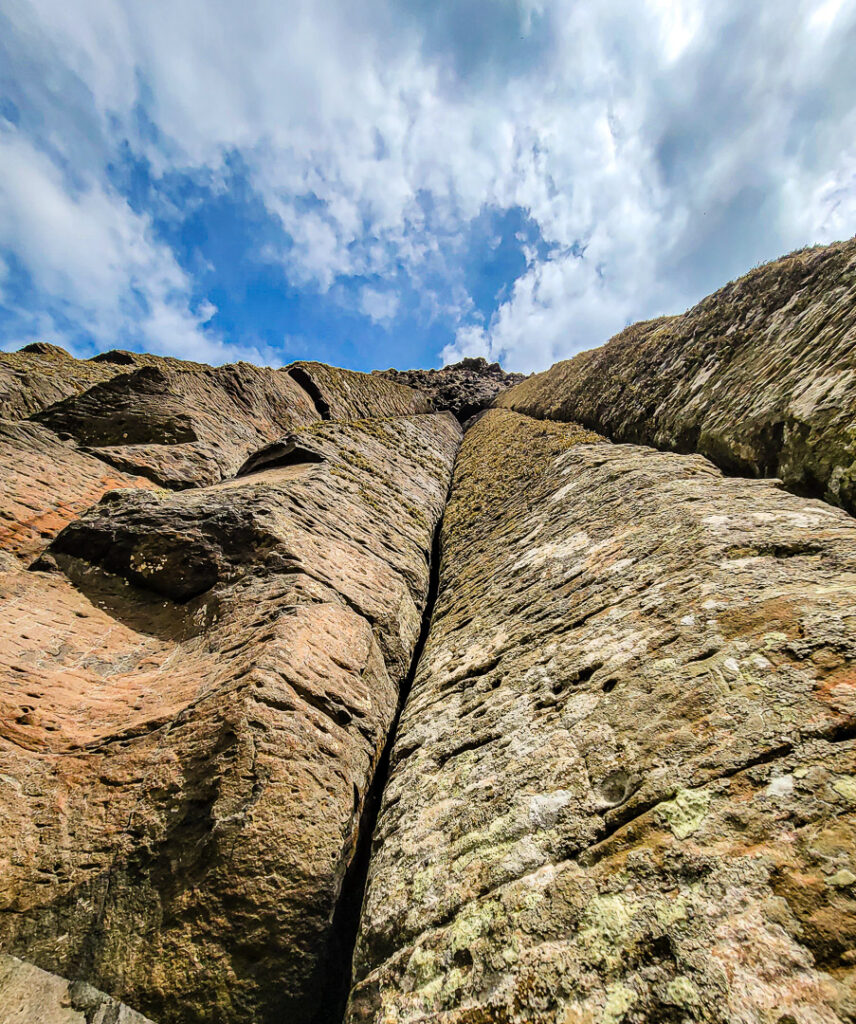



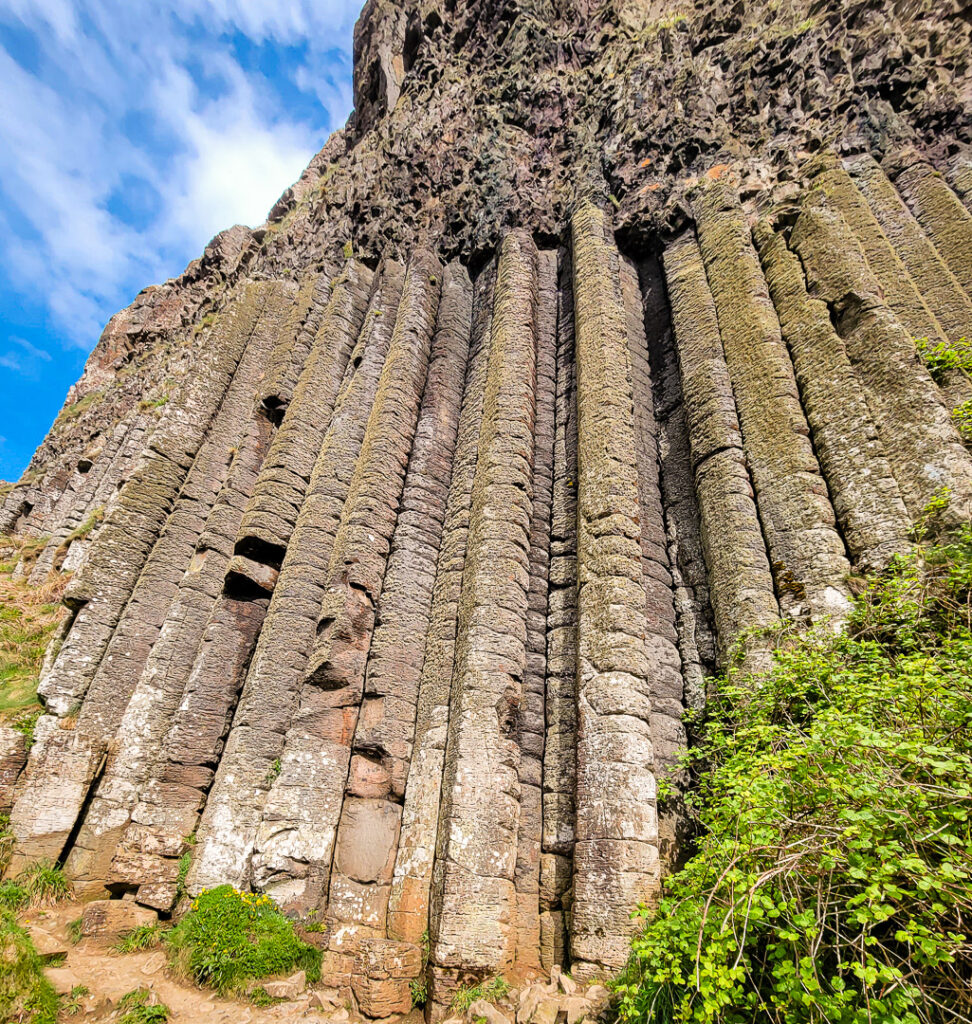



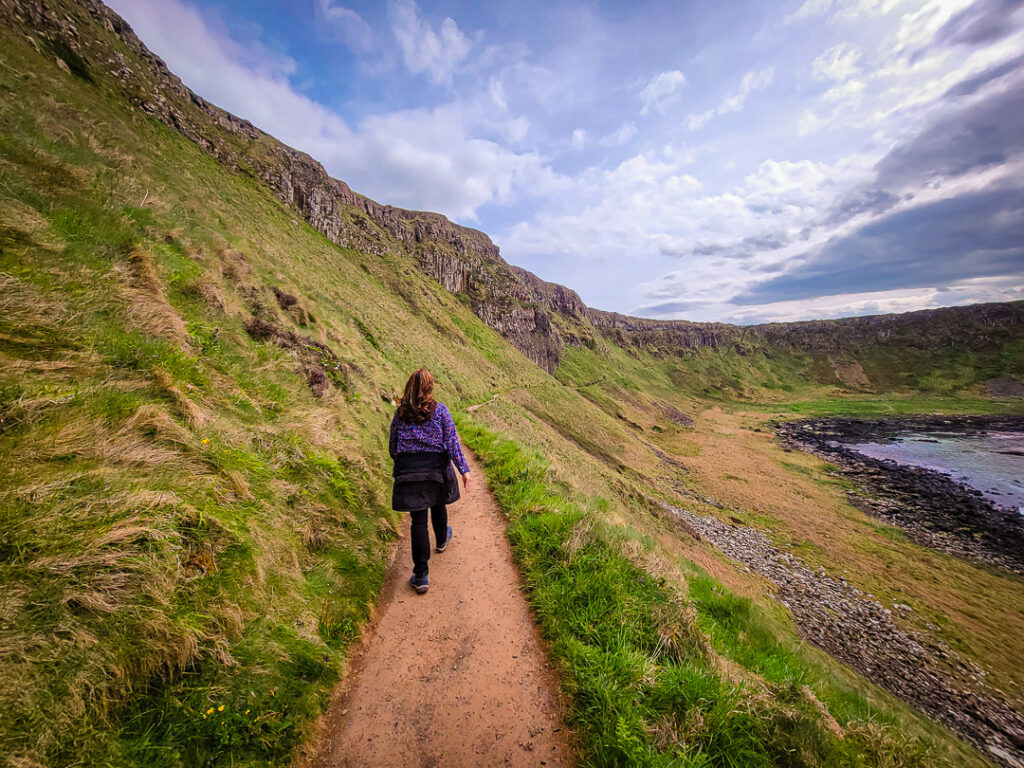
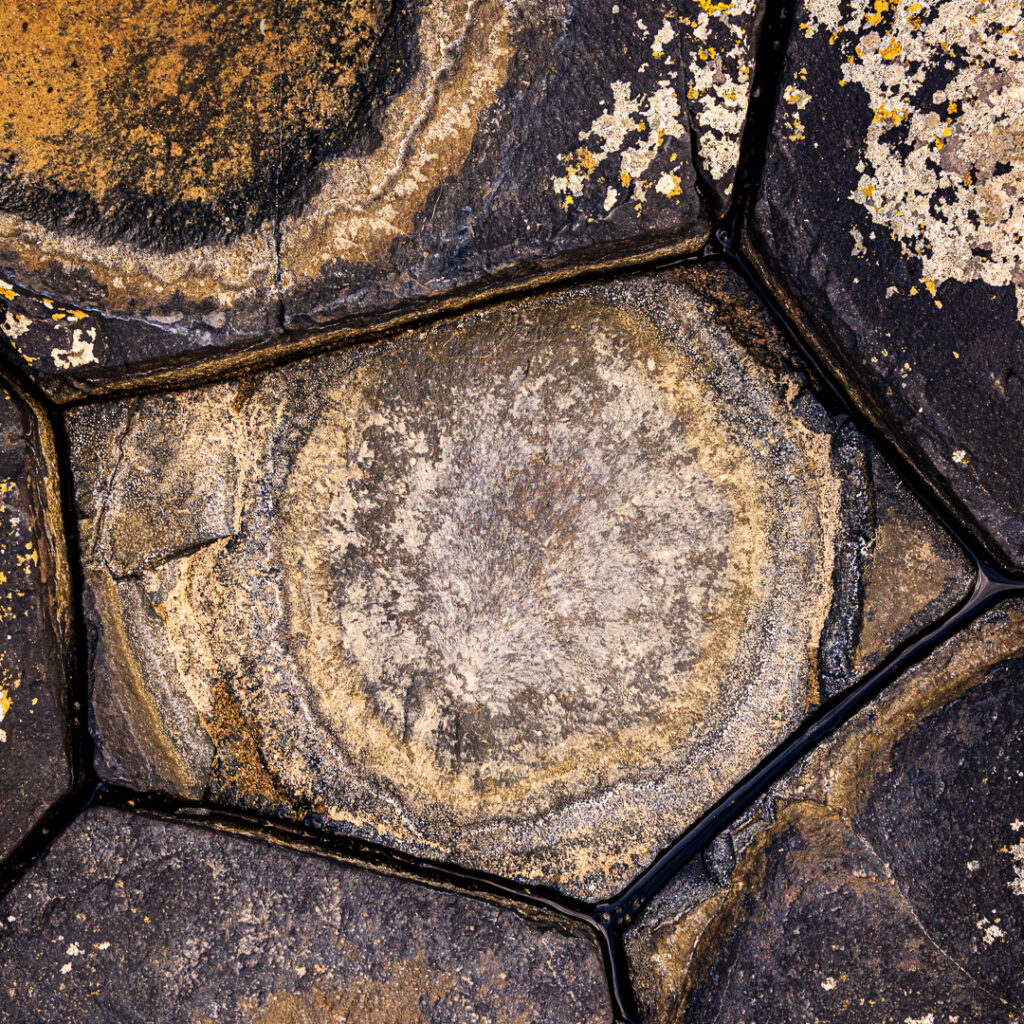
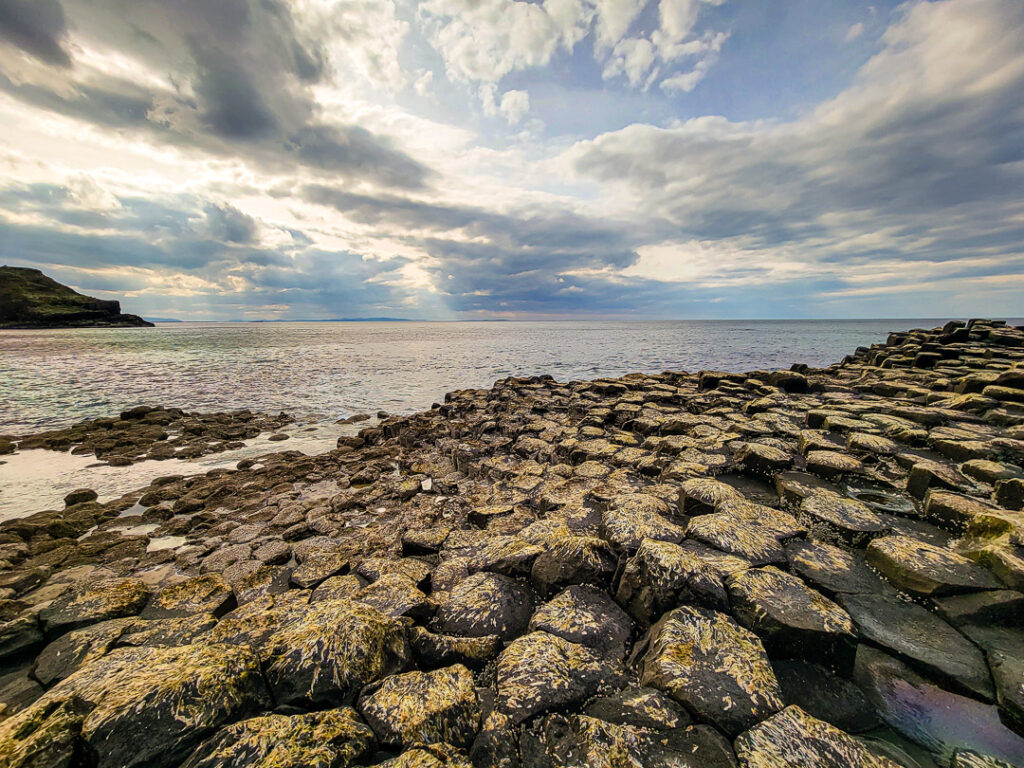
Belfast Experience: A City of History and Heart
Our final stop on this journey was Belfast, the capital of Northern Ireland. The city is steeped in history, from its world-famous shipbuilding legacy, including the construction of the RMS Titanic and her sister ship, the Olympic, to the turbulent decades of The Troubles.
Growing up, I watched news reports of bombings and unrest in Northern Ireland. While the conflict was undeniably tragic, it left a lasting impression on me. So, I was eager to explore Belfast and this part of history. We scheduled a Black Cab through our hotel and toured the streets and heard firsthand stories about the neighborhoods, murals, and the people who lived through those decades of turmoil. The drive in the back of the Black Cab, finally connected the dots from my childhood to the city’s real history.
Some murals were bright and celebratory, while others were somber and reflective. The tour brought the story of The Troubles vividly to life, offering a unique perspective on Belfast and the resilience of its people. I highly recommend the Black Cab Tours for anyone hoping to truly understand the city’s past.
A Brief Overview of The Troubles:
The Troubles lasted from the late 1960s until the Good Friday Agreement in 1998. This decades-long conflict arose from deep political, cultural, and religious divisions. Largely Protestant unionists wanted Northern Ireland to remain part of the United Kingdom, while largely Catholic nationalists sought a united Ireland.
Violent flashpoints such as Bloody Sunday in 1972, when British soldiers shot unarmed civil rights protesters in Derry, and the 1981 hunger strike led by Bobby Sands drew global attention. These events left deep scars but ultimately demonstrated that violence could not resolve the conflict. The Good Friday Agreement established a framework for dialogue and reconciliation, setting Northern Ireland on a path toward peace.
For those wanting to dive deeper into the stories and human experiences of this period, here are suggested films to watch:
In the Name of the Father (1993) – A powerful drama about injustice, family, and the fight against wrongful imprisonment during The Troubles.
Hunger (2008) – A stark portrayal of the 1981 hunger strike led by Bobby Sands, highlighting the human cost of the conflict.
’71 (2014) – A tense thriller following a young British soldier caught in Belfast during the height of the violence.
Belfast (2021) – Kenneth Branagh’s semi-autobiographical take on growing up in the city during the early days of the conflict.
The following day after our tour of neighborhoods of The Troubles, we explored Belfast on foot enjoying the local food and people watching. Easy to get lost in the surroundings and city architecture.
Belfast and the Declaration of Independence
Belfast also holds a fascinating link to American history. On August 23, 1776, the Belfast News Letter became the first newspaper outside of America to publish the full text of the Declaration of Independence, before King George III had even received it. At the time, Ireland was under British rule, making this publication all the more remarkable.
The scoop was thanks to Robert and Henry Joy, proprietors of the paper and active members of the local civic community. Robert Joy even designed Clifton House, which served as Belfast’s Poor House, and he visited it regularly. Their efforts ensured that news of the revolutionary declaration reached an international audience, providing a unique historical connection between Ireland and the birth of the United States.

